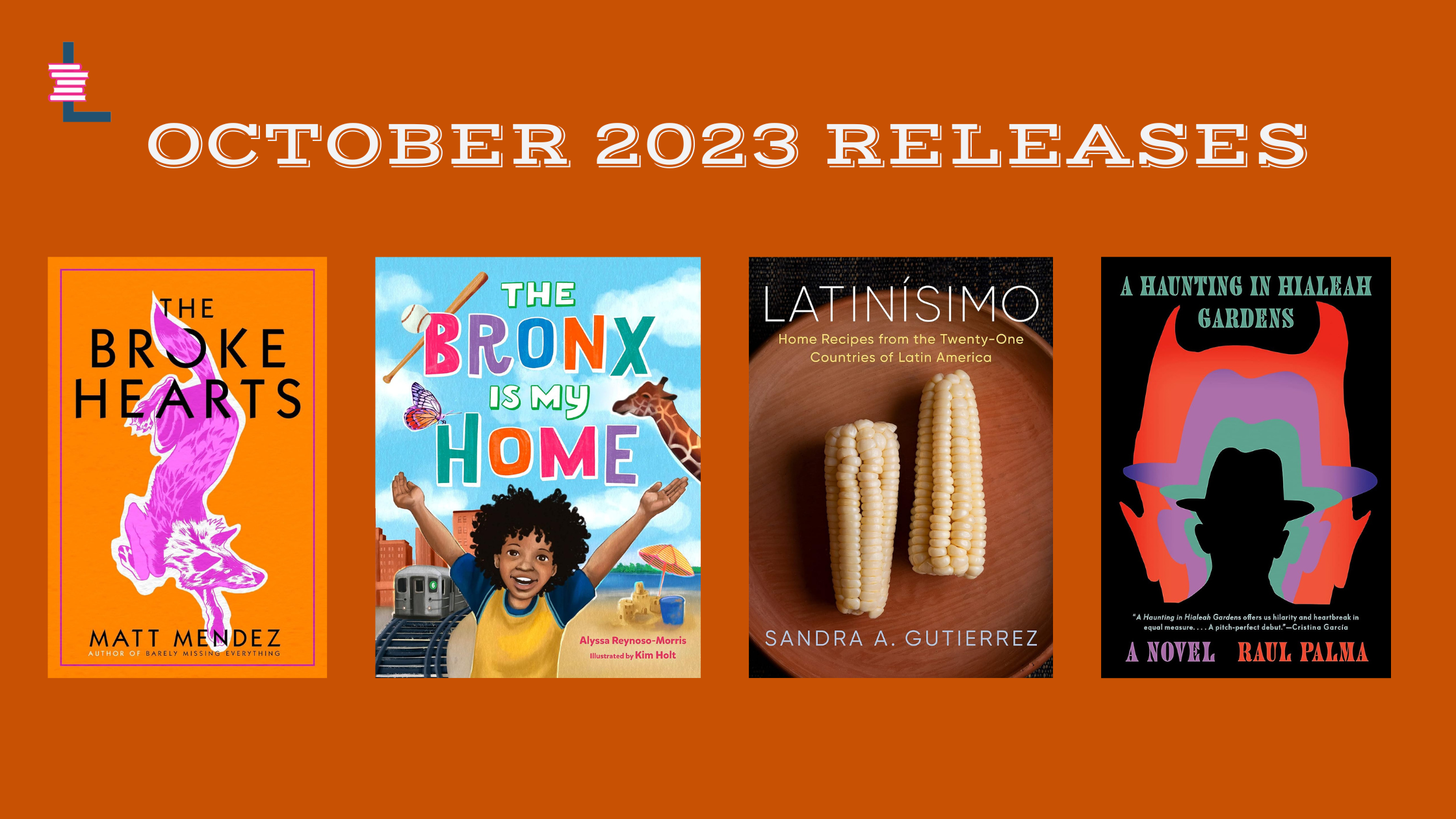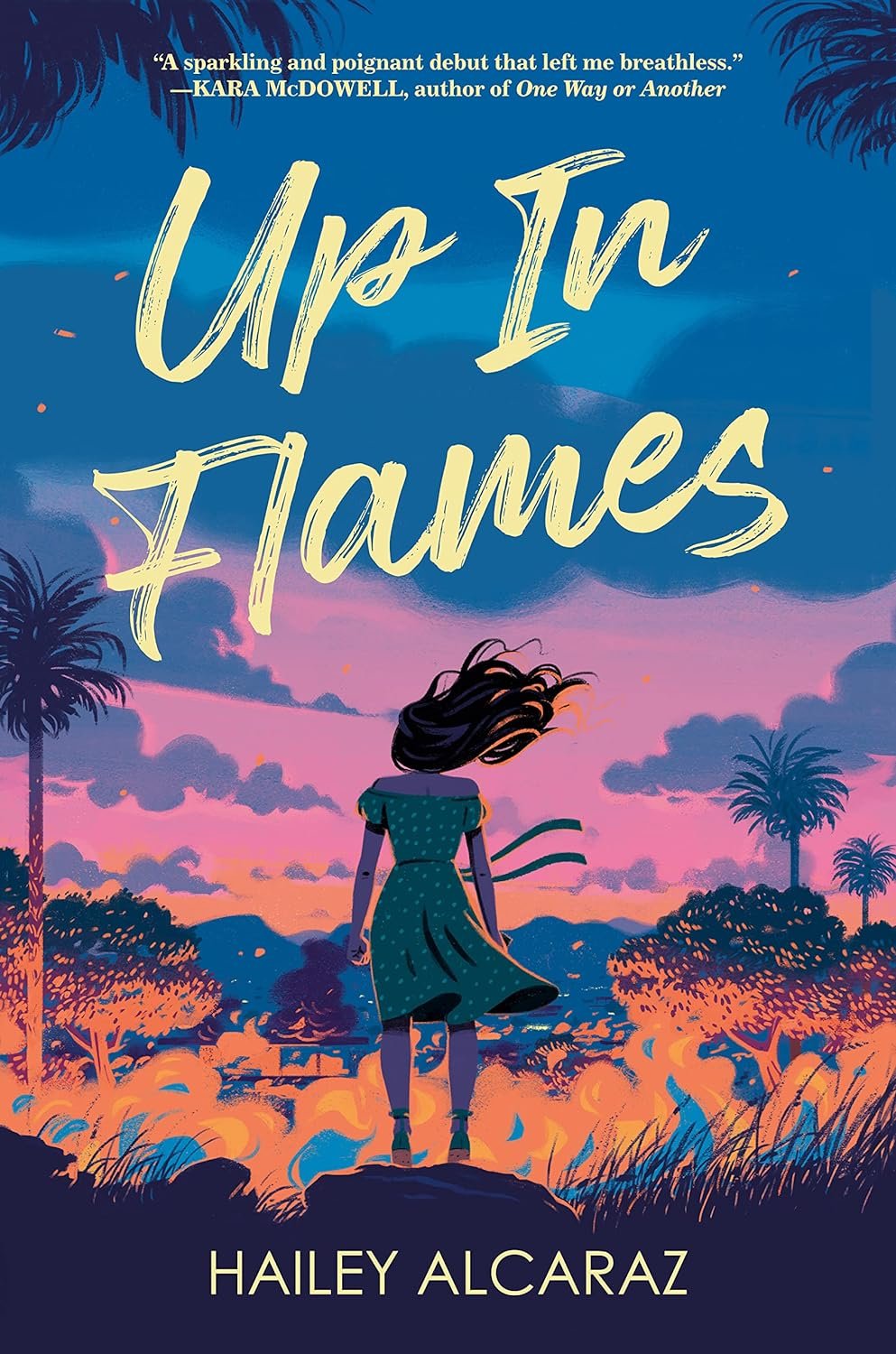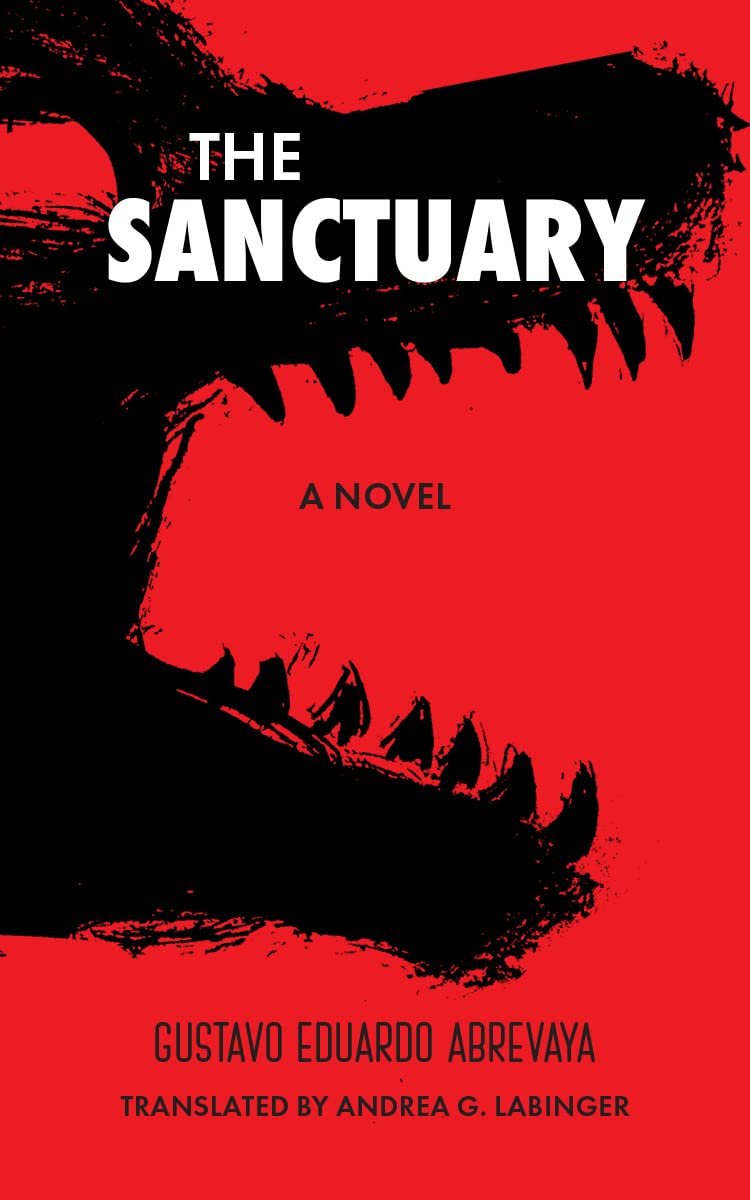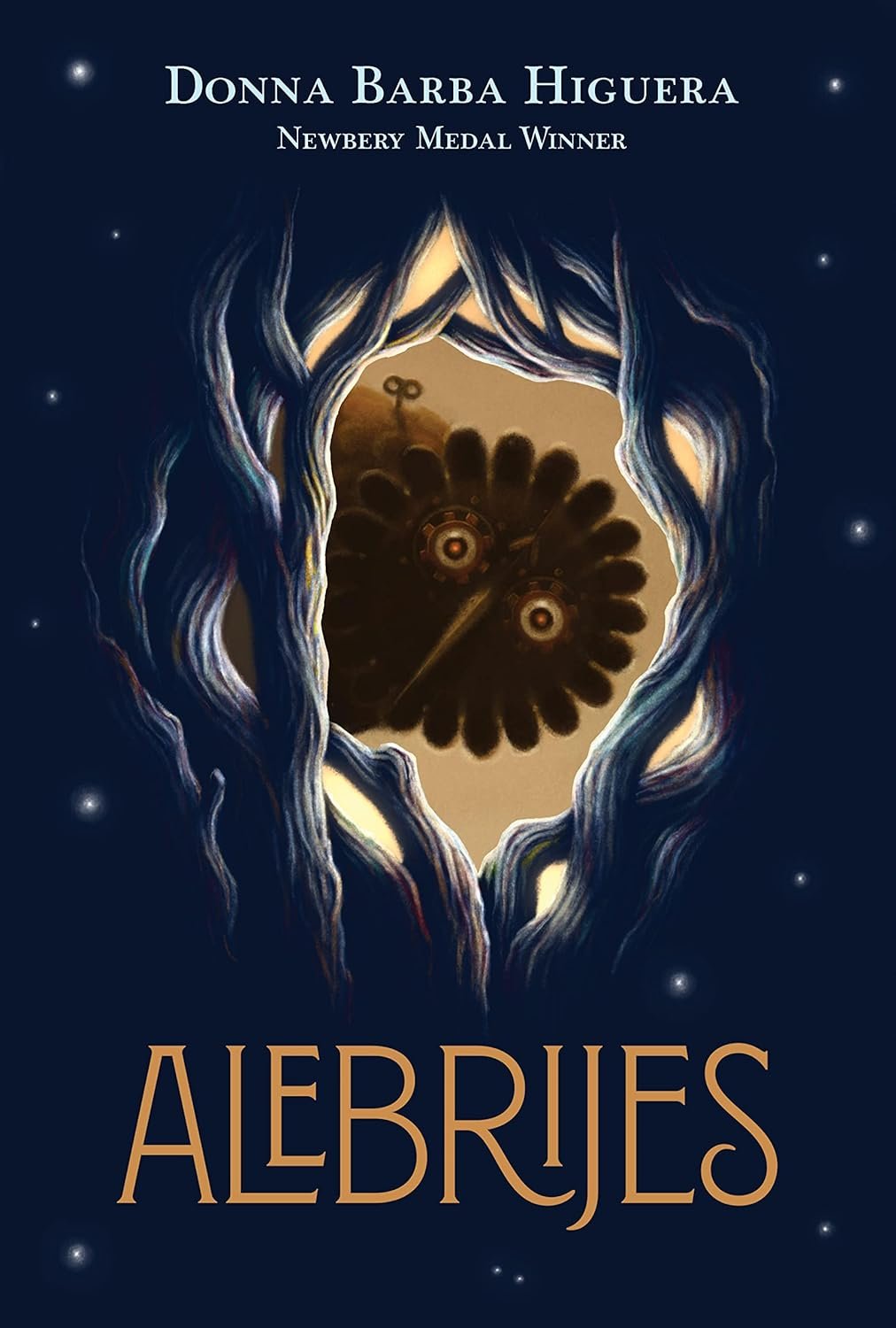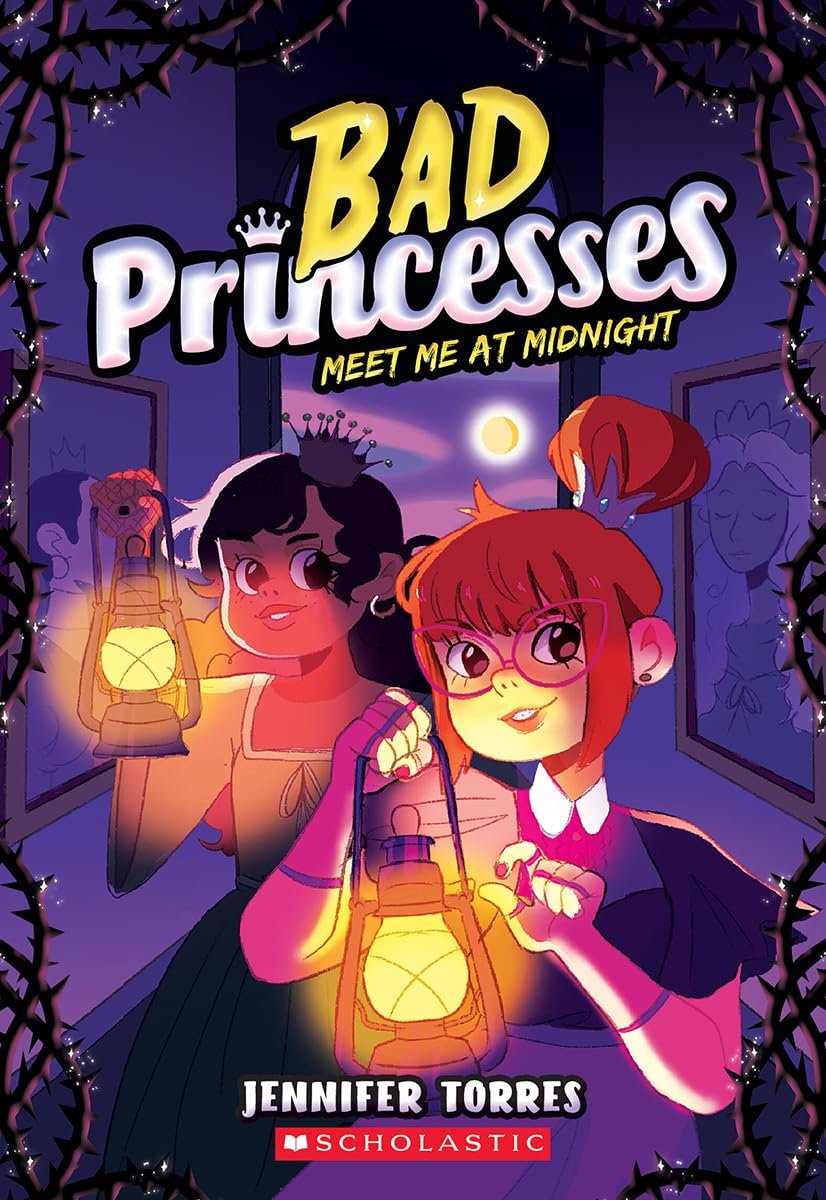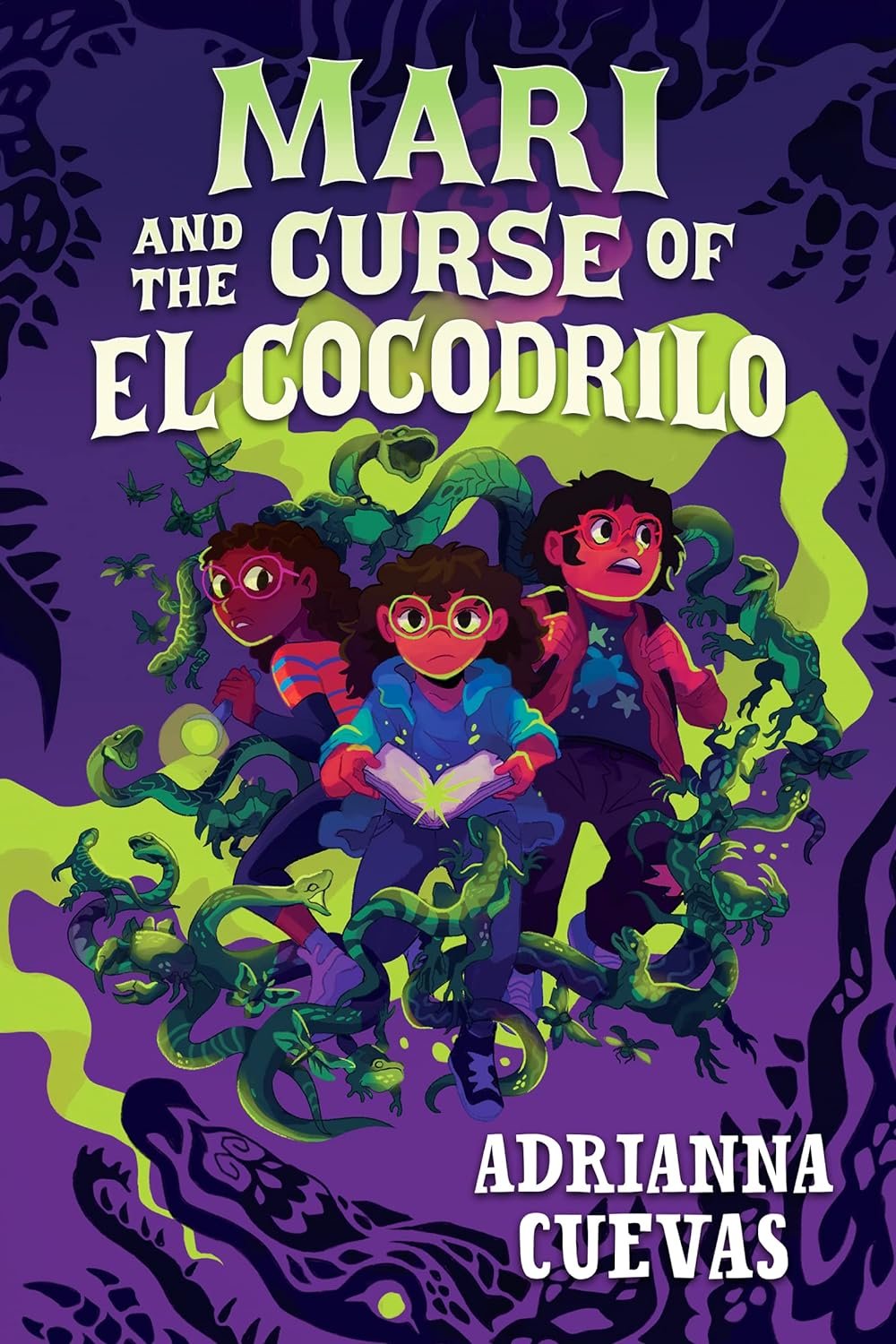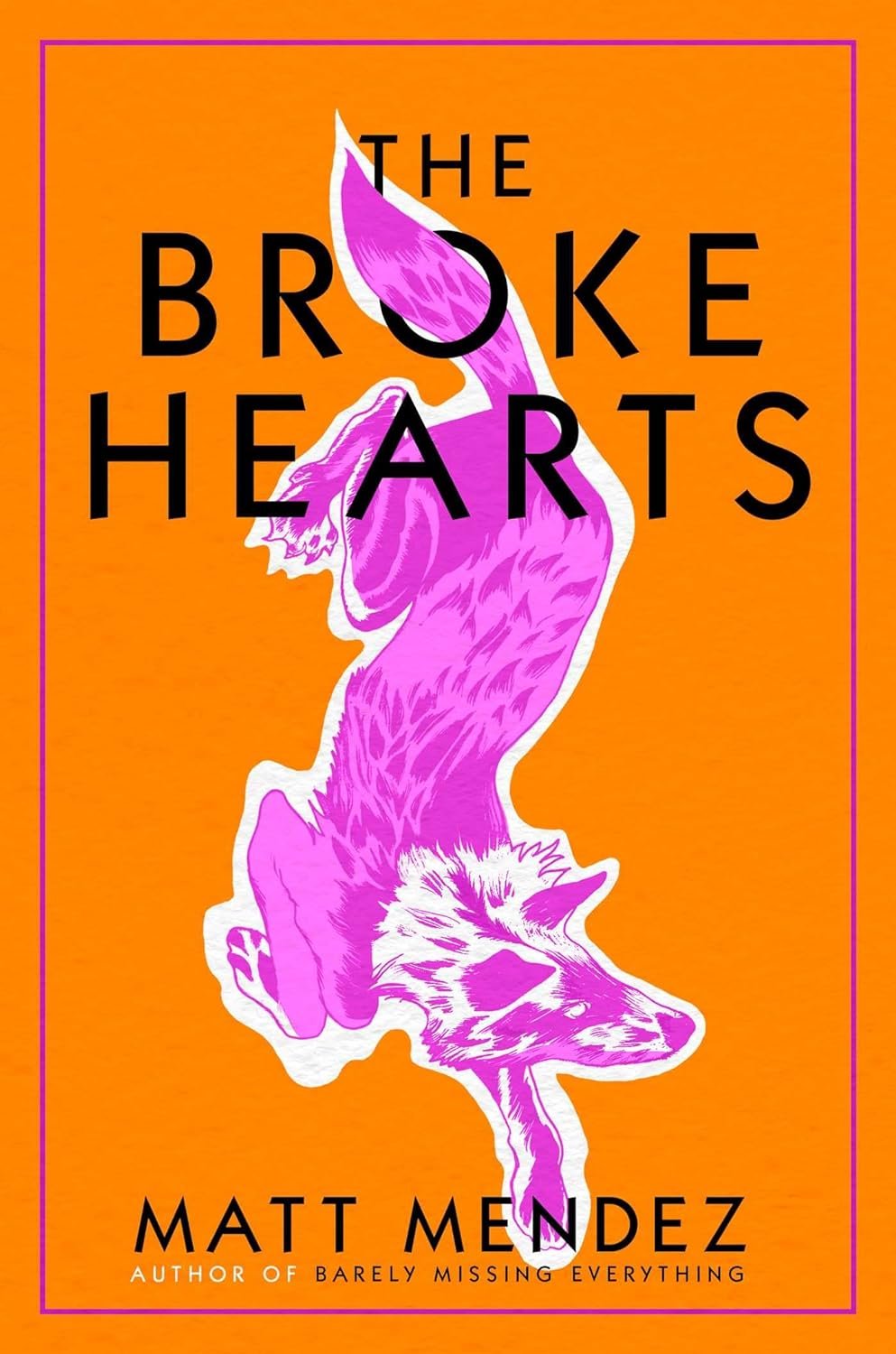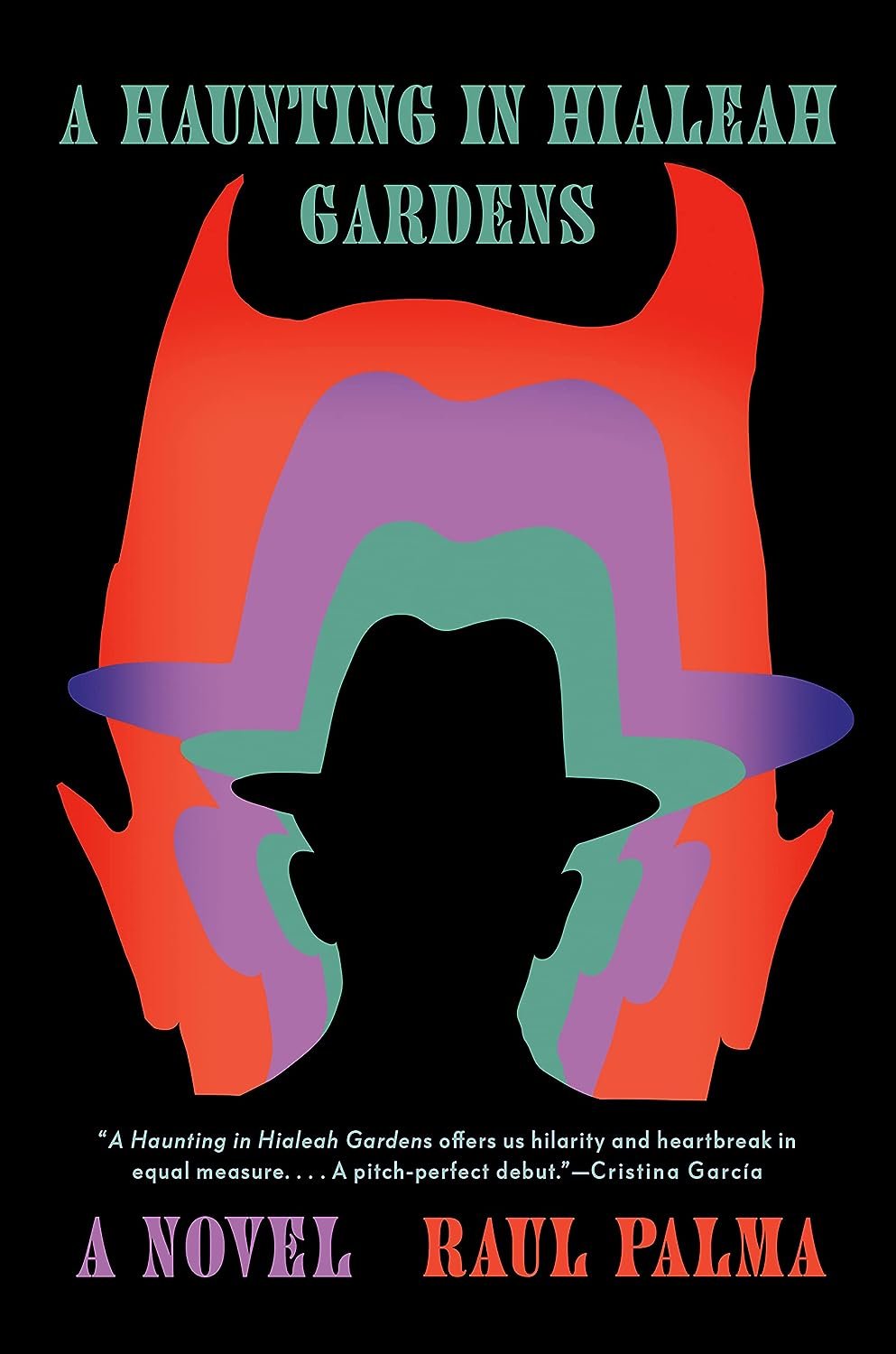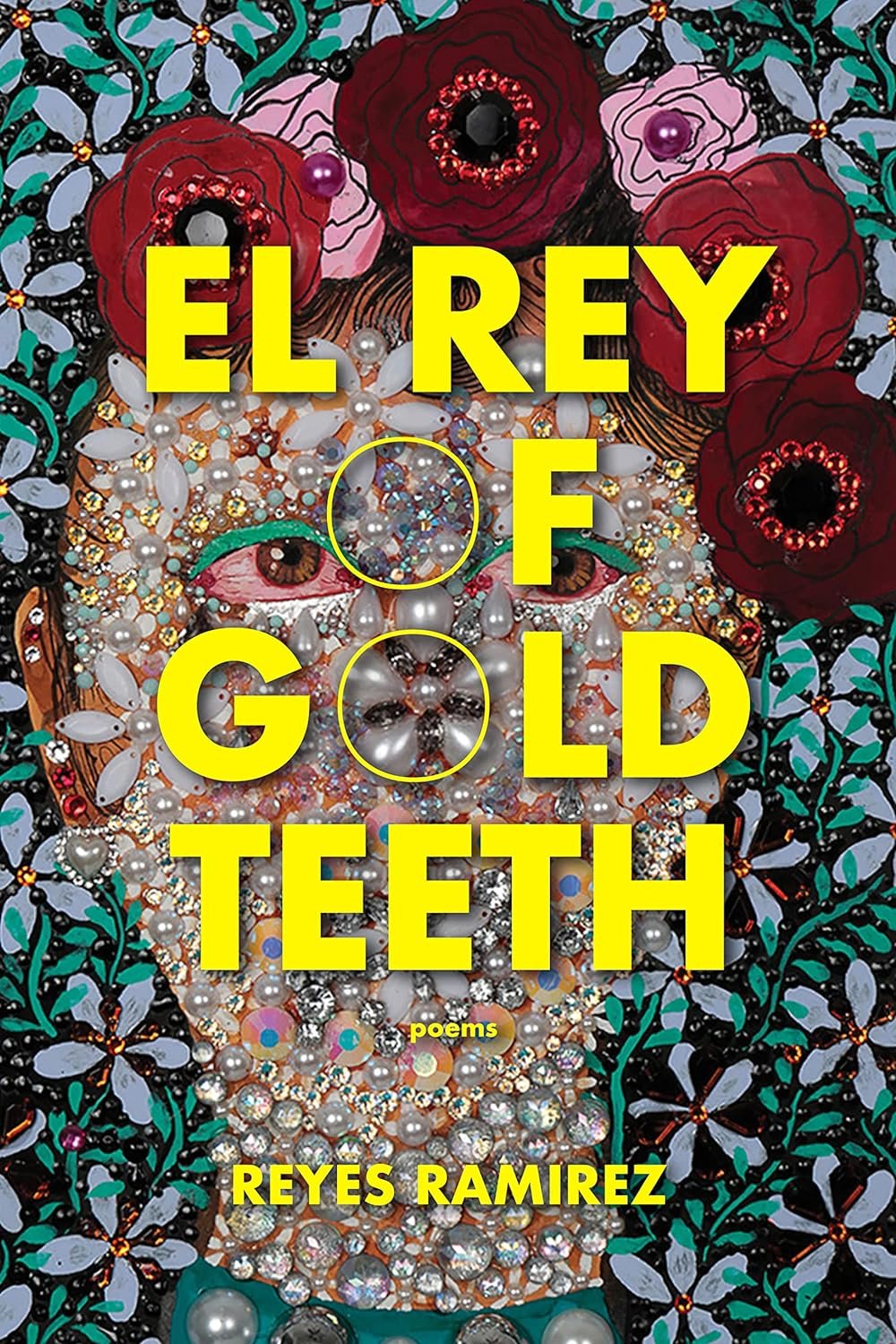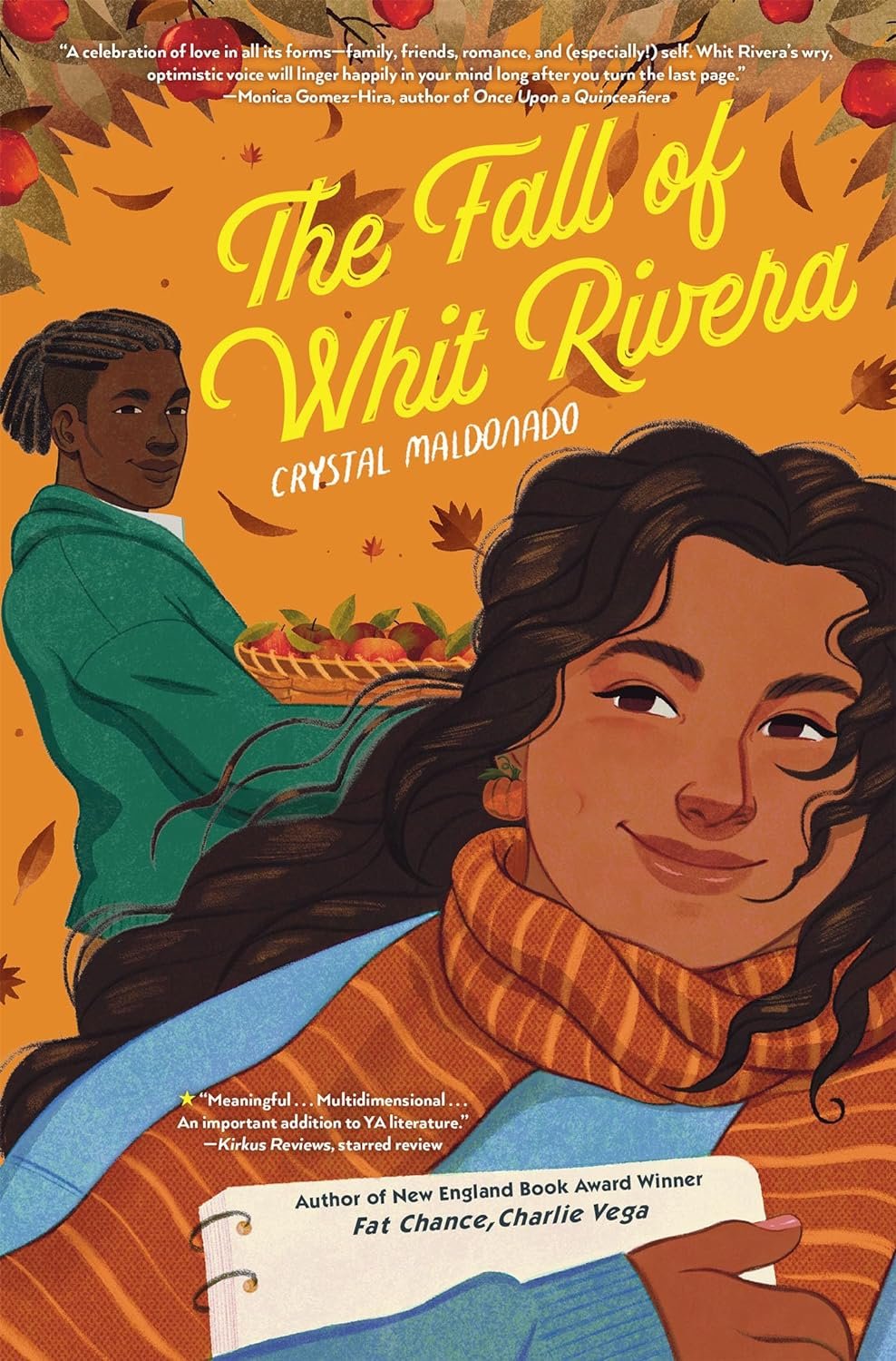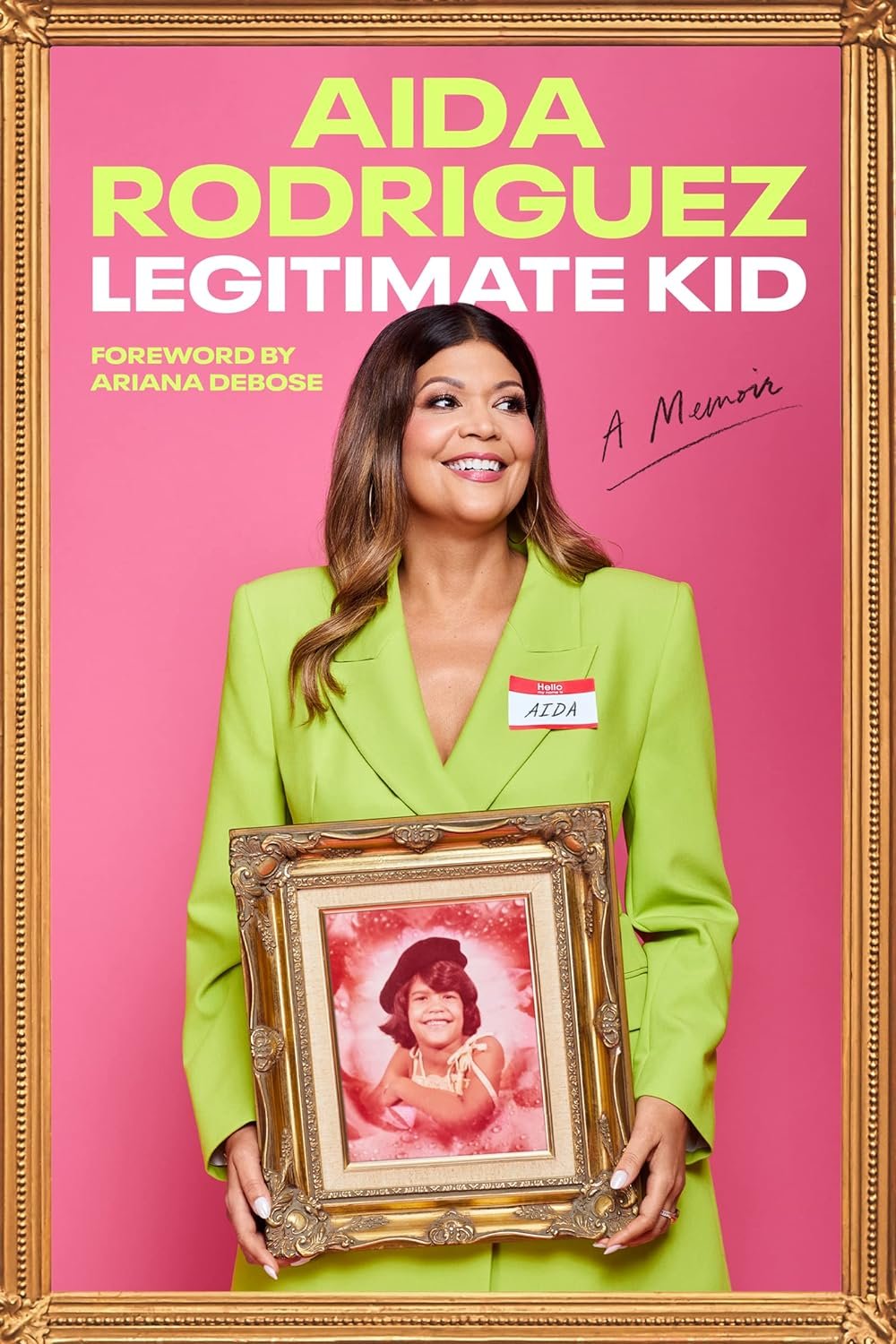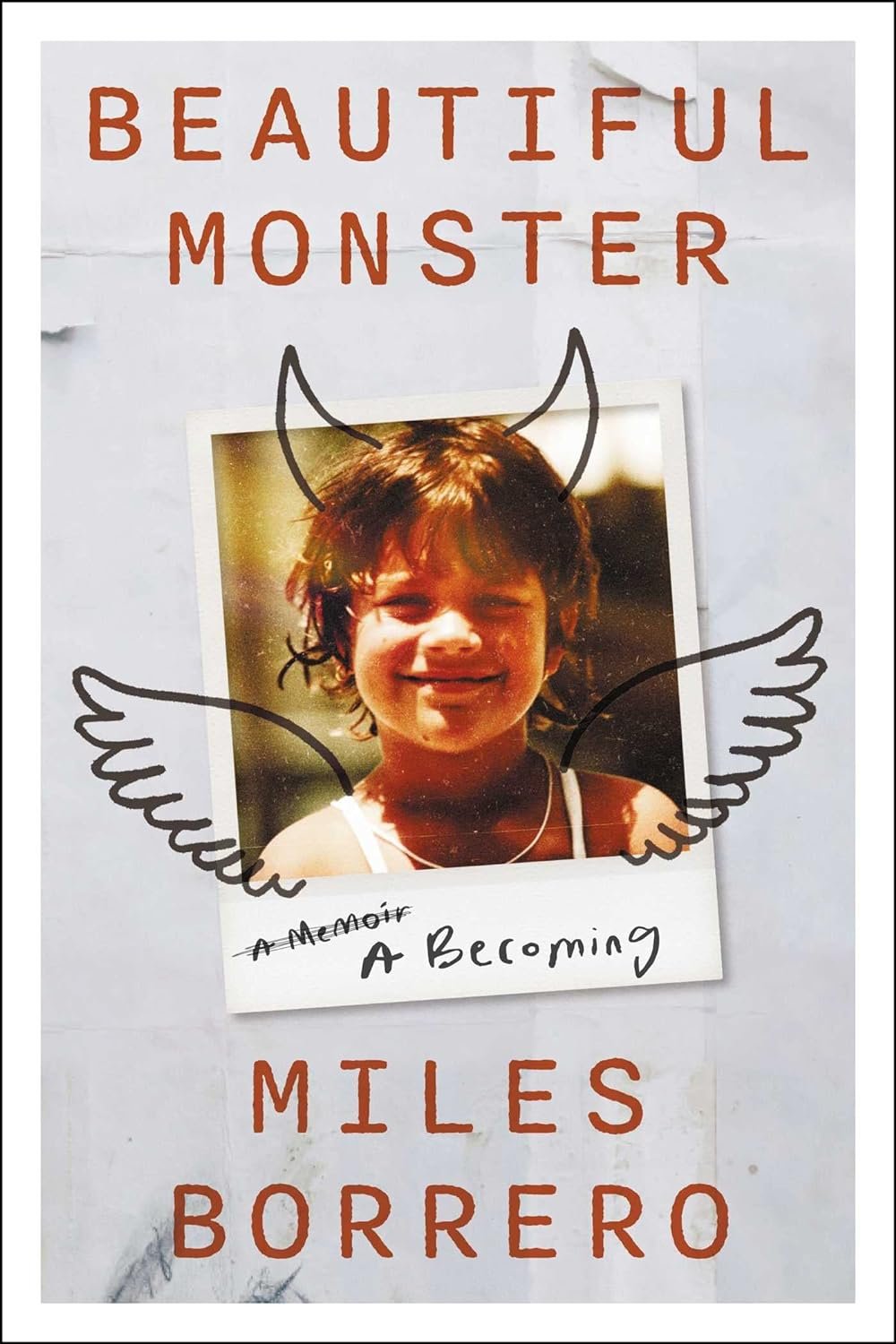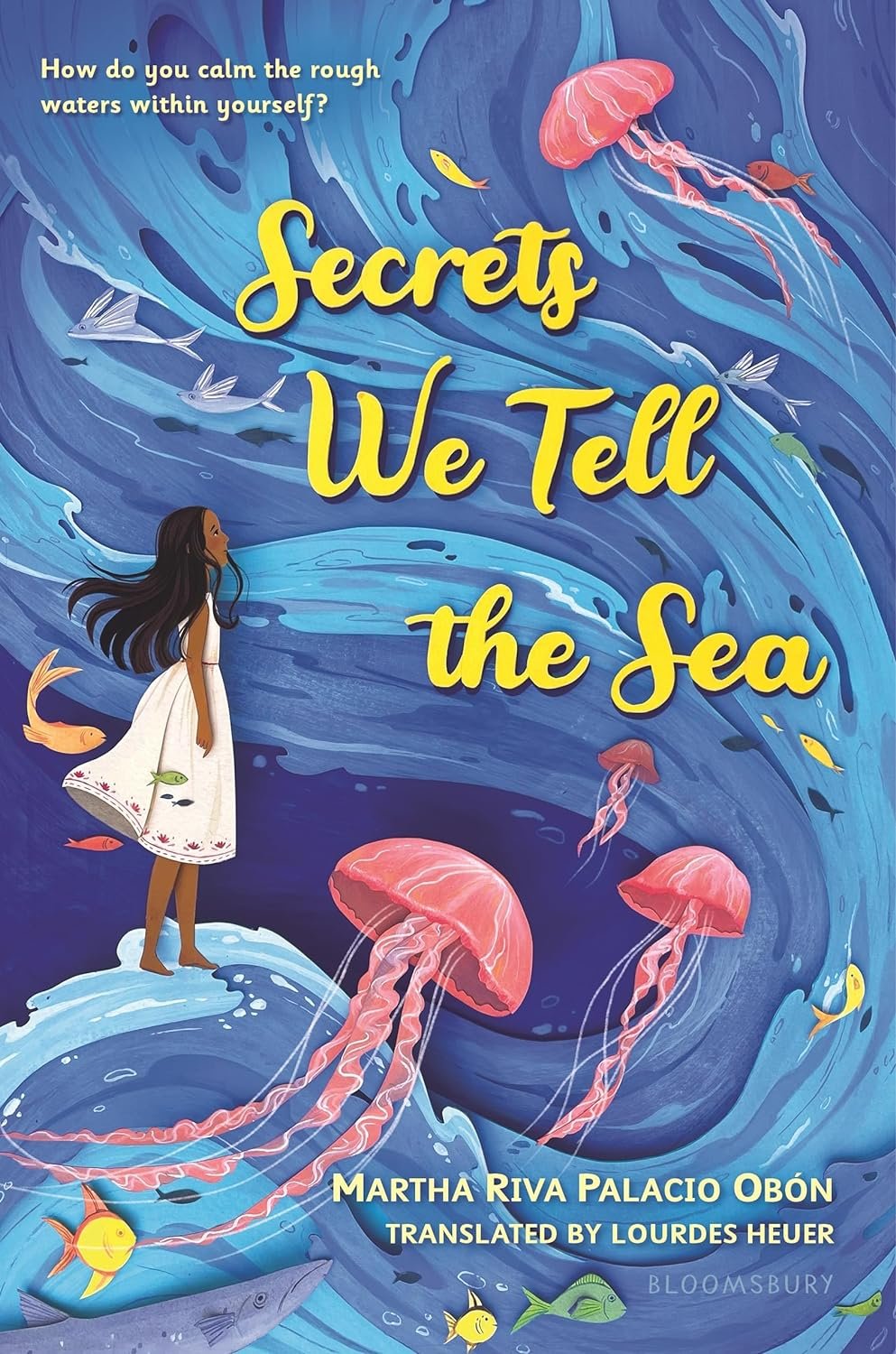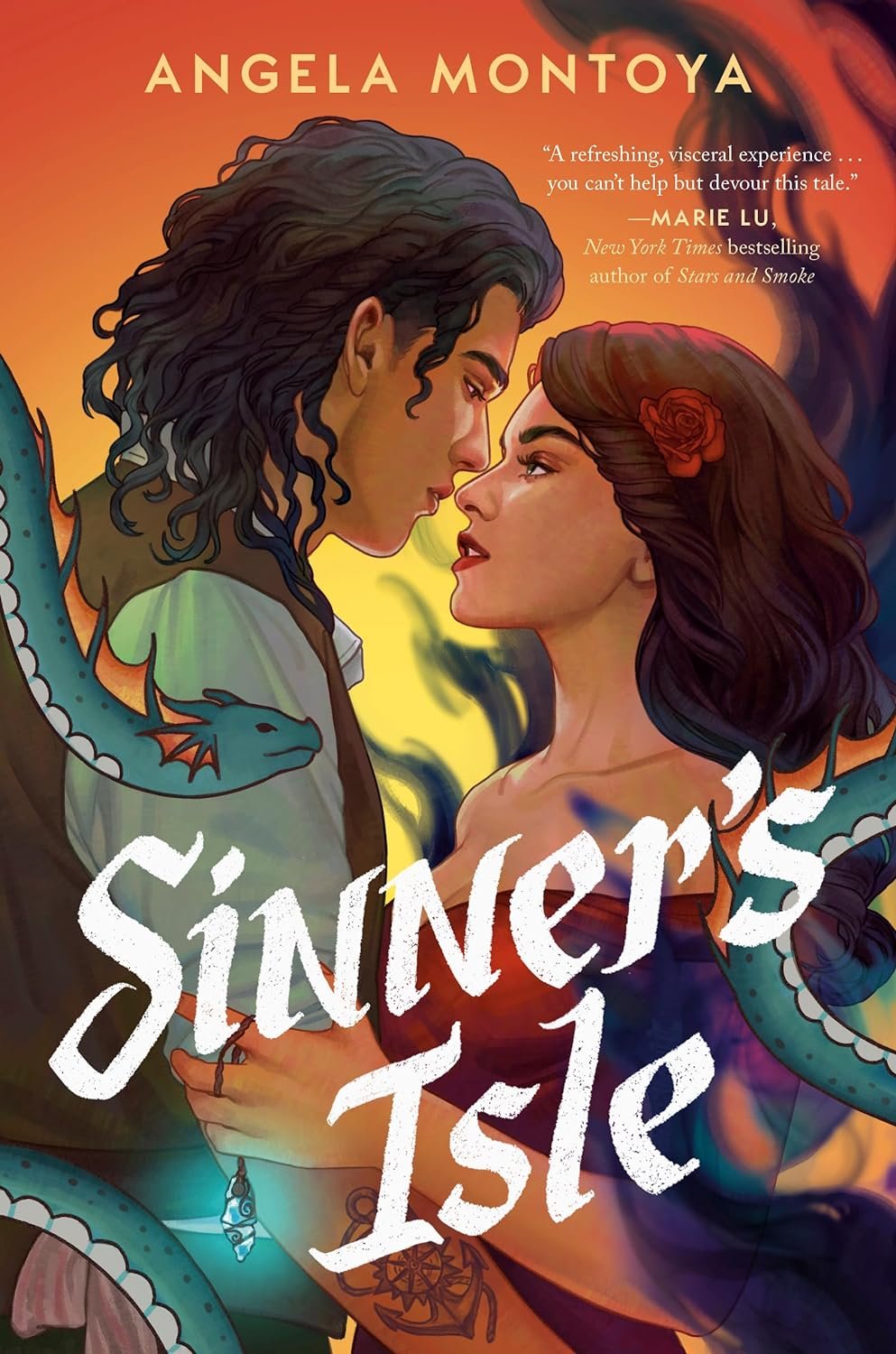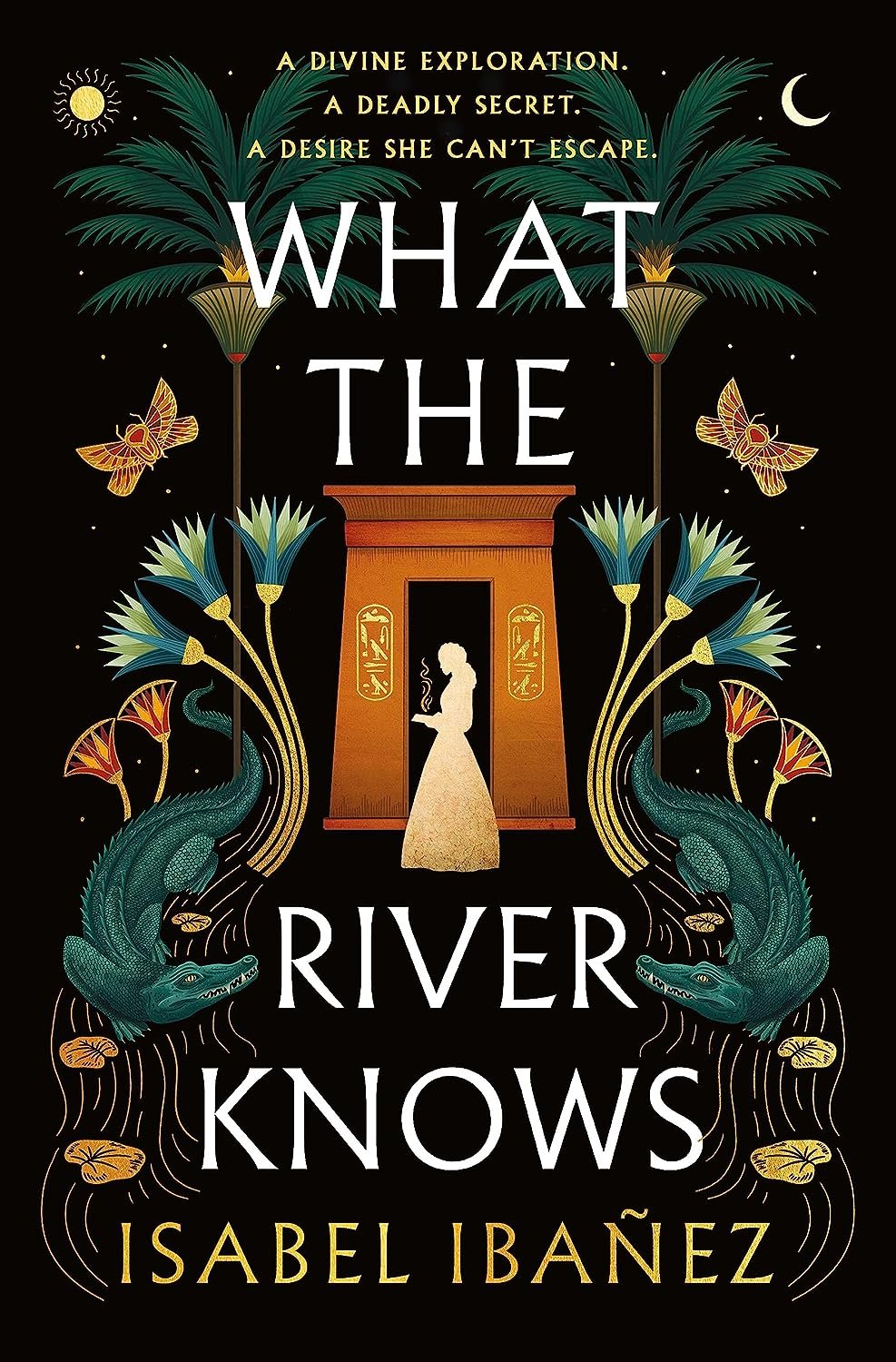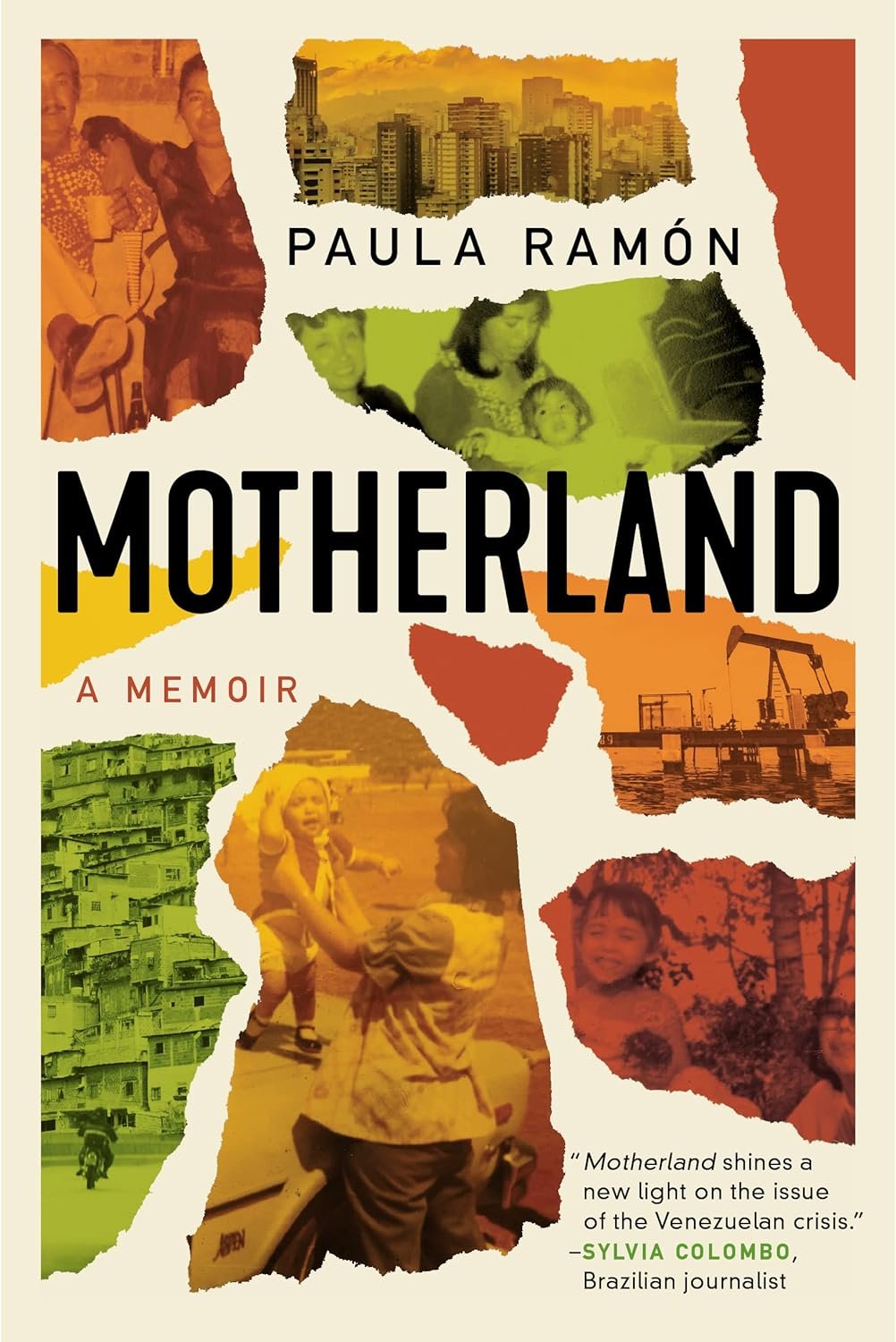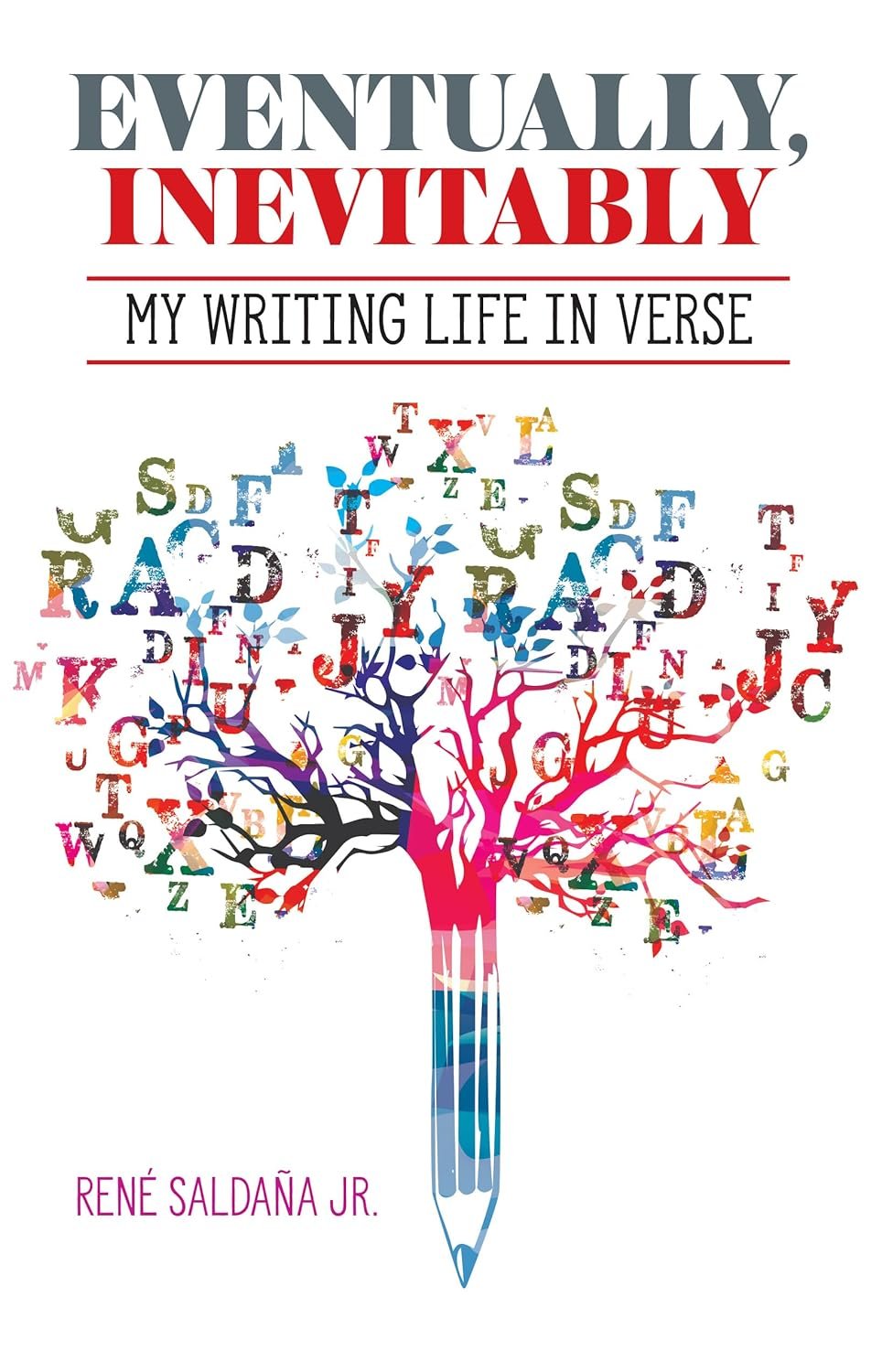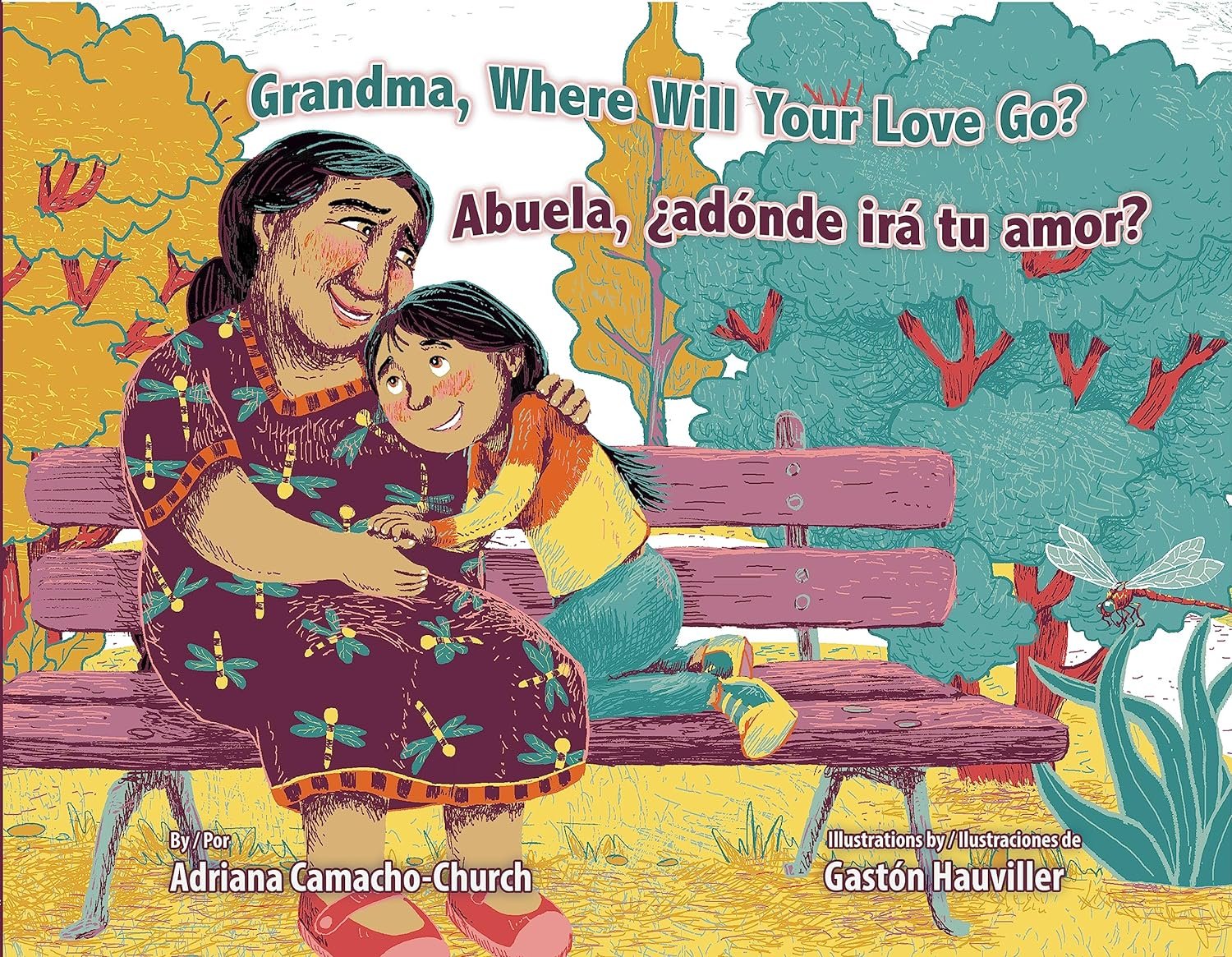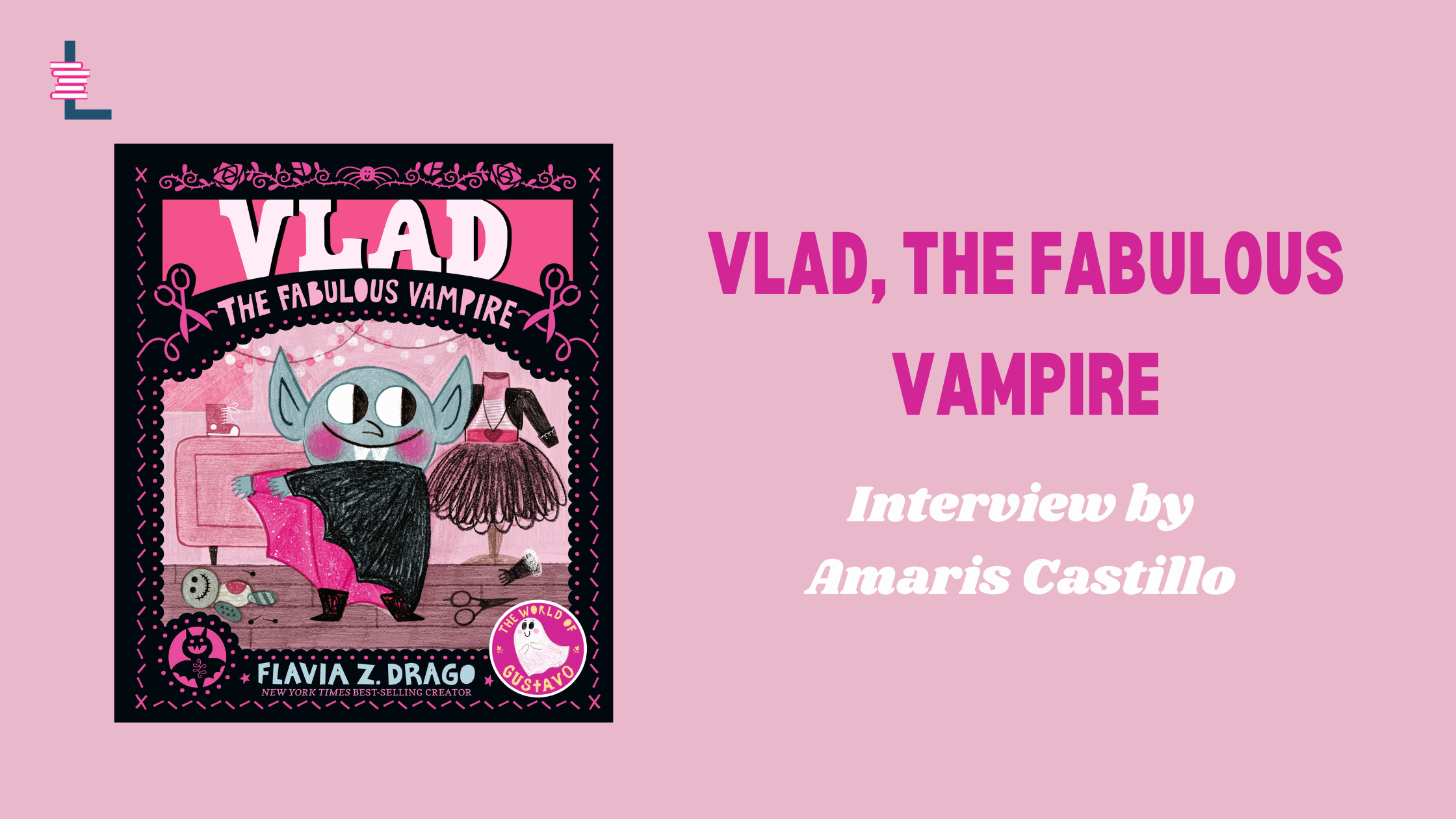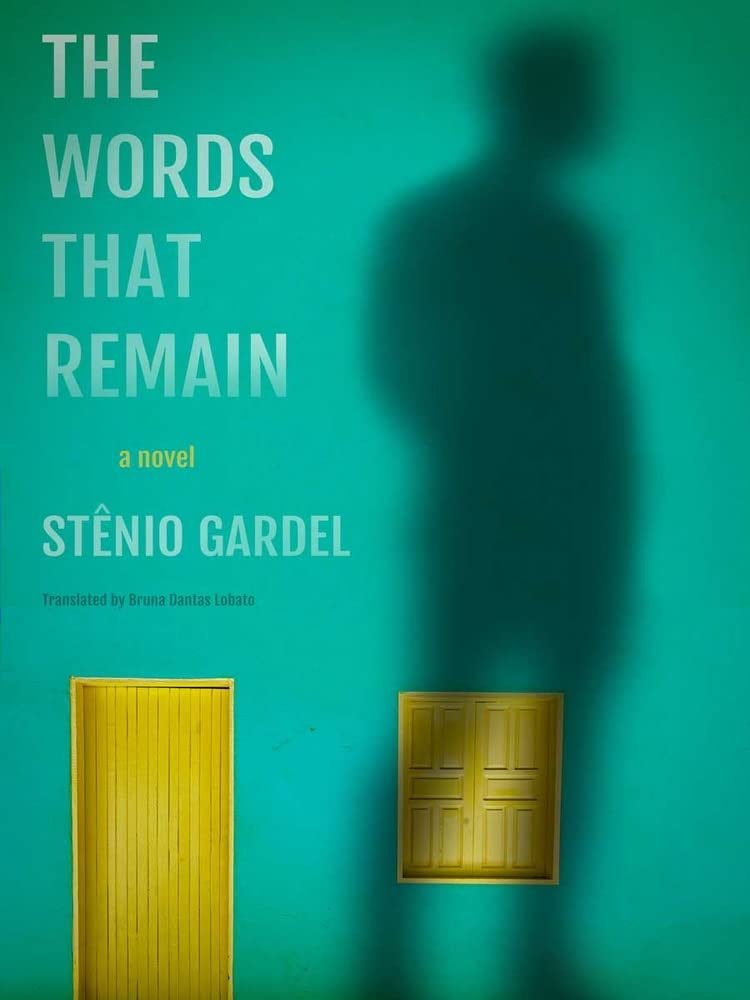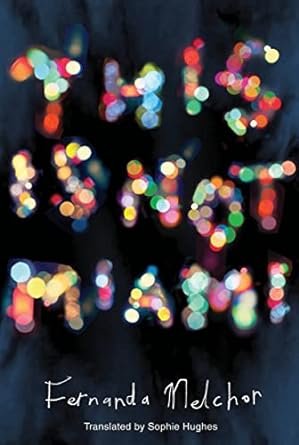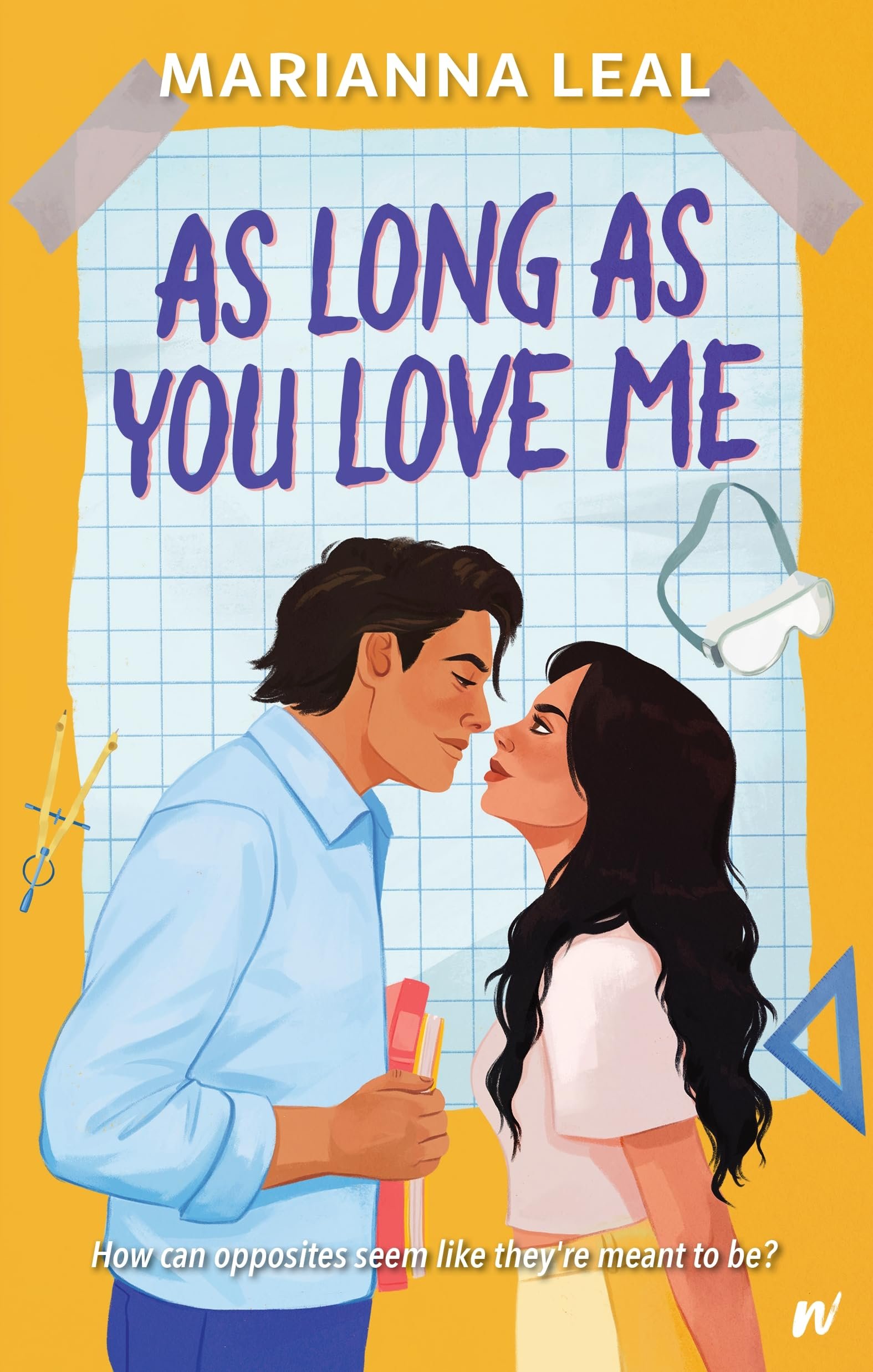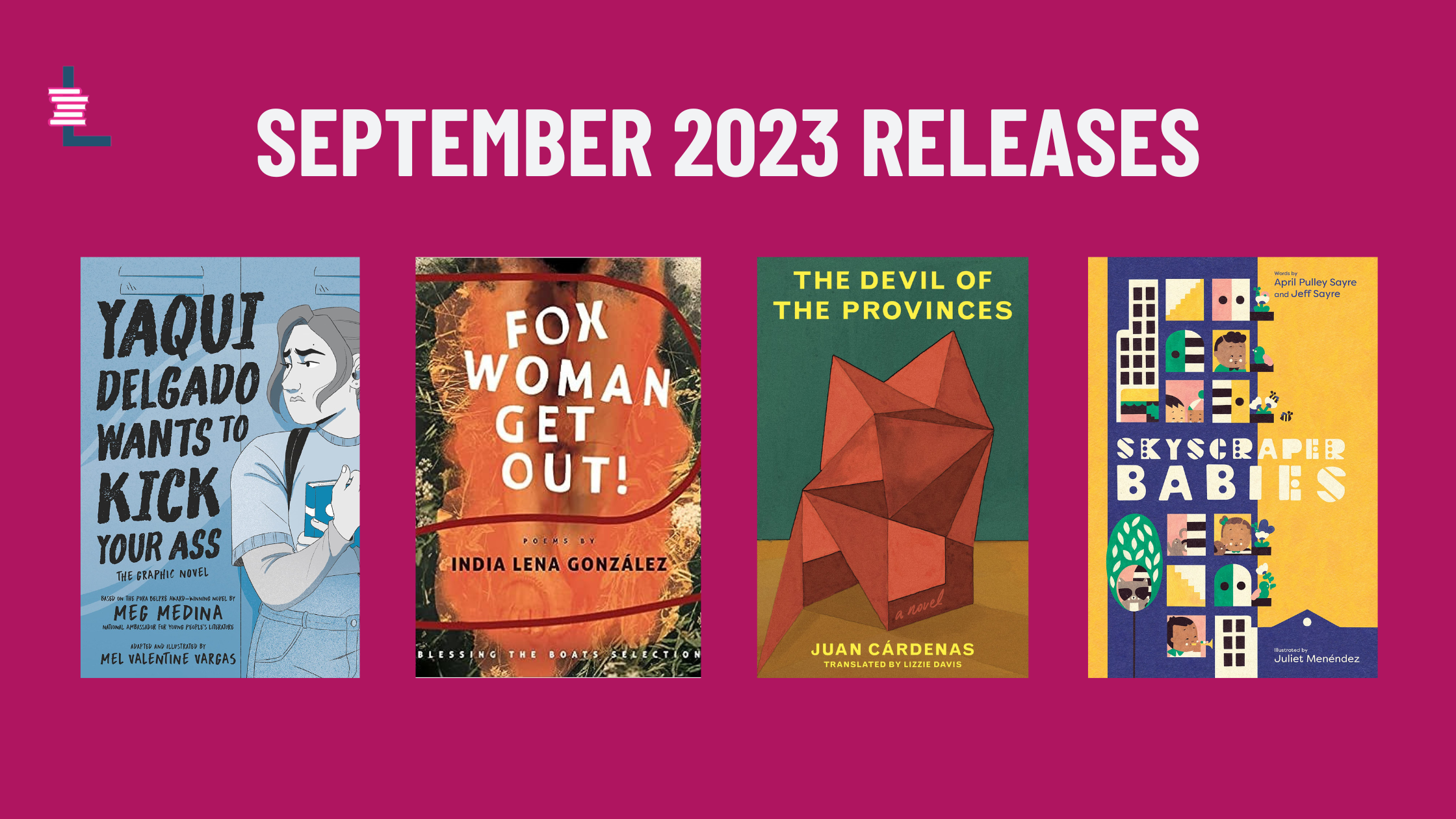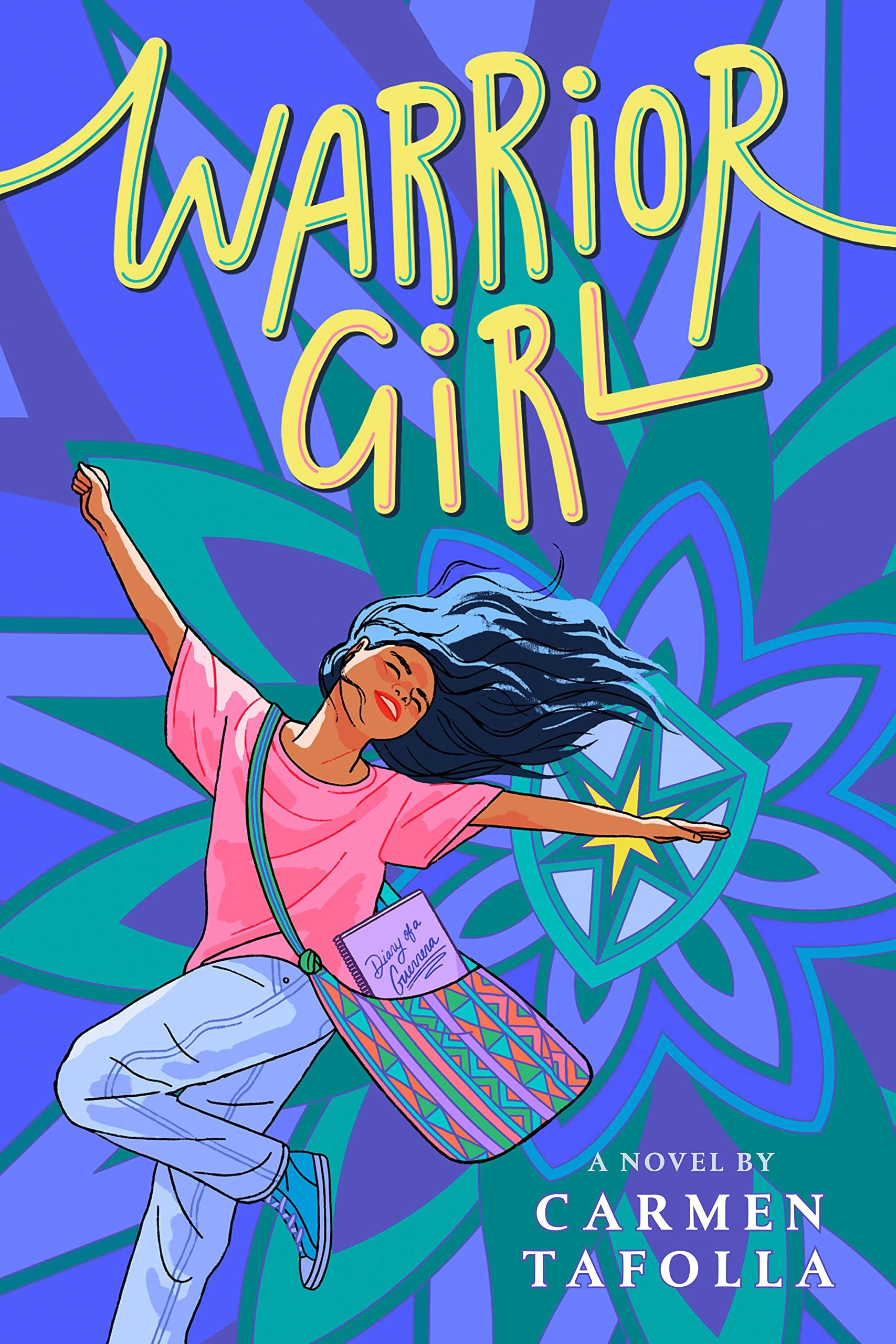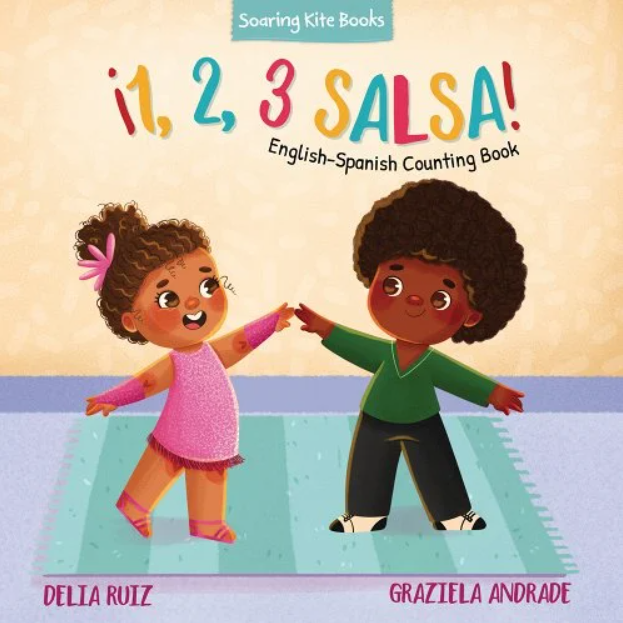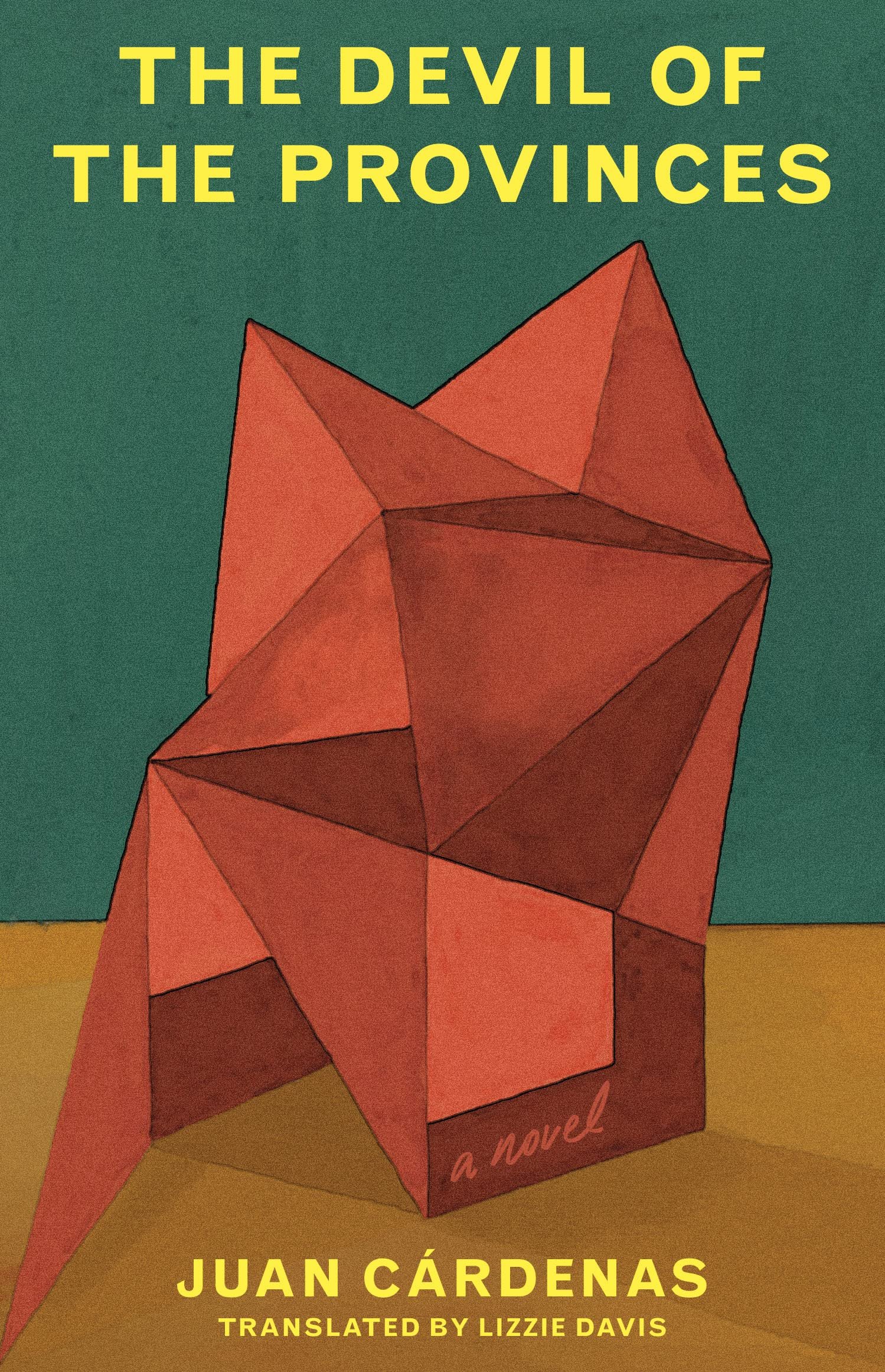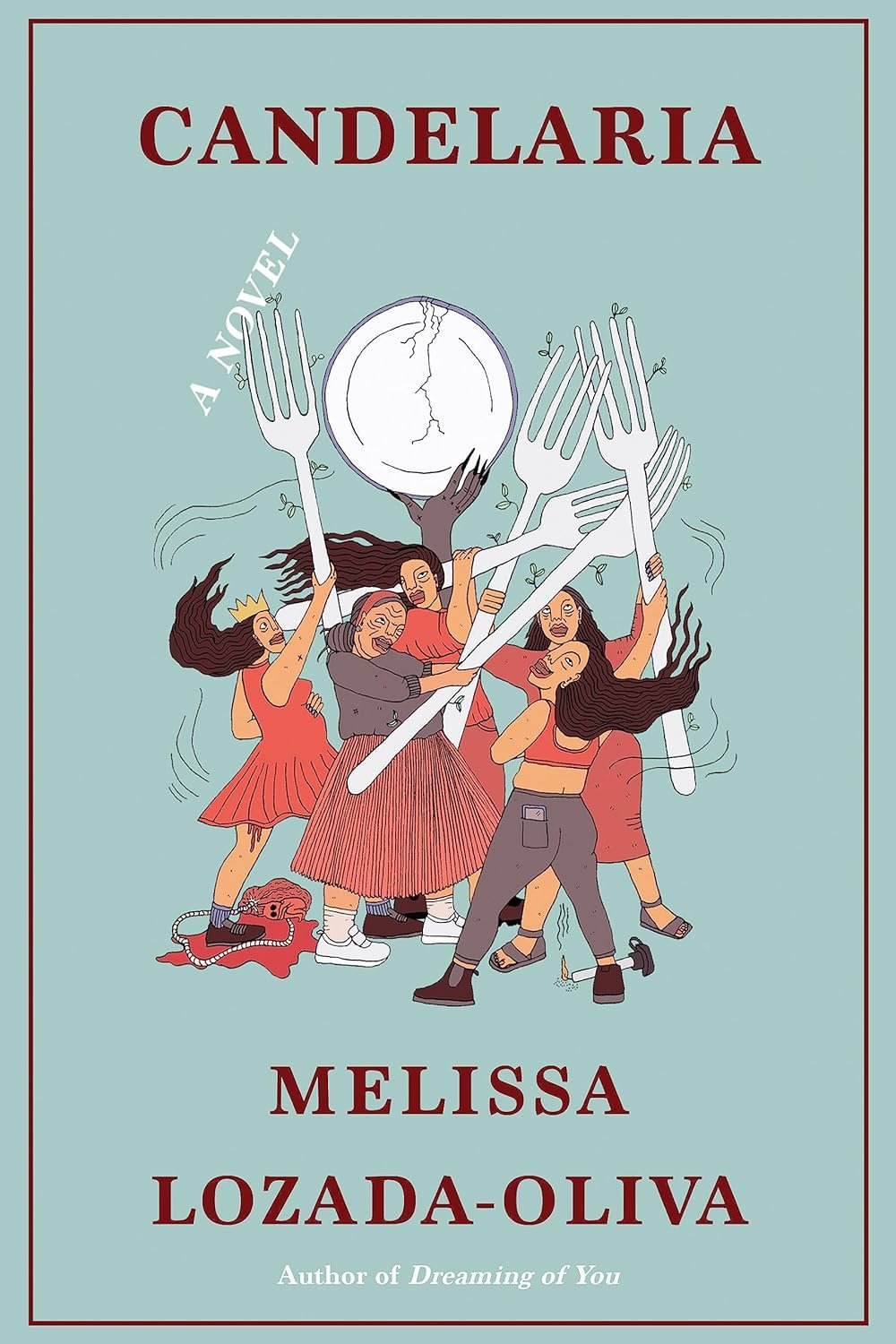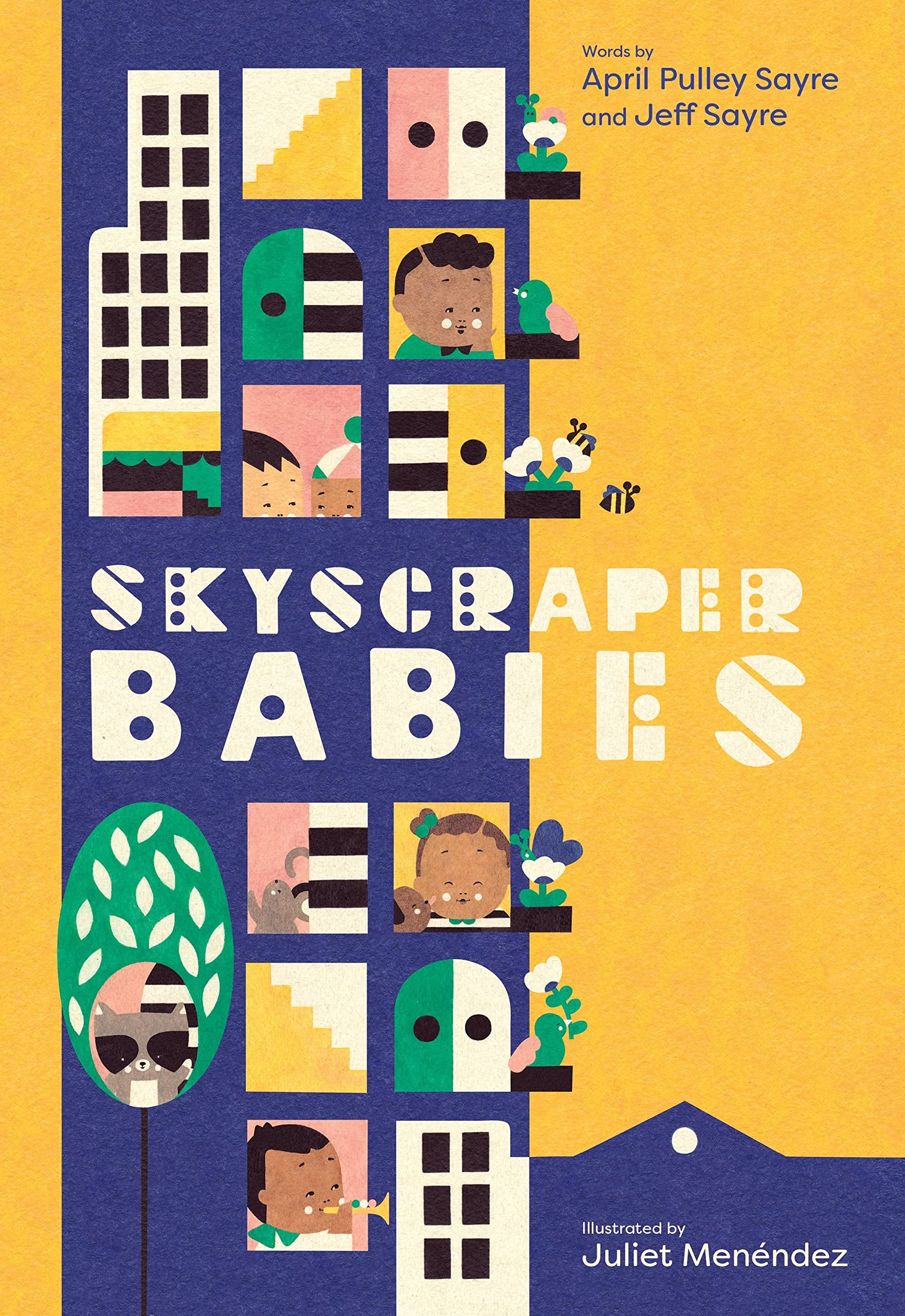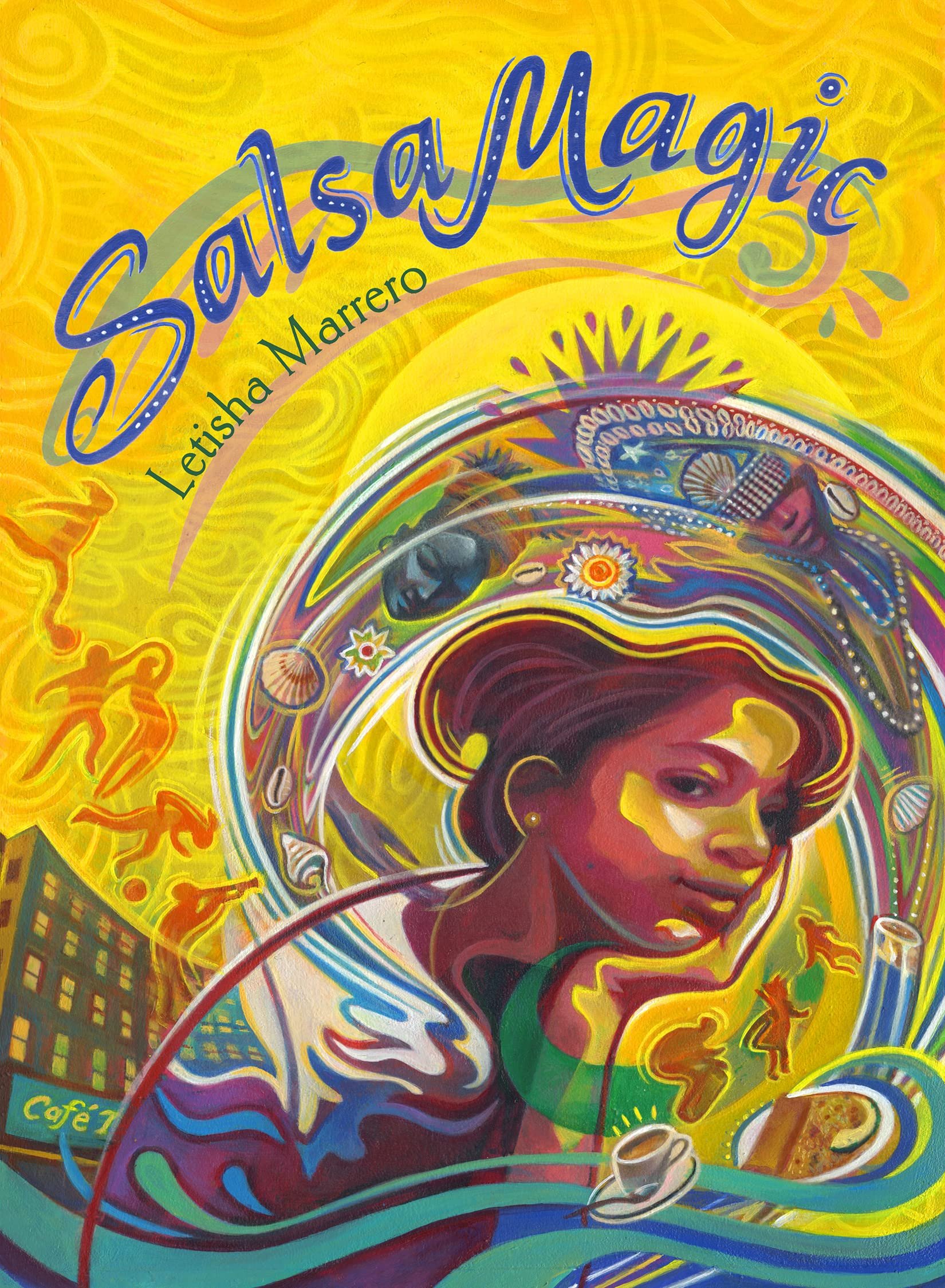On Sale October 3
Up in Flames by Hailey Alcaraz | YOUNG ADULT
At eighteen, Ruby Ortega is an unapologetic flirt who balances her natural aptitude for economics with her skill in partying hard. But she couldn't care less about those messy college boys—it's her intense, brooding neighbor Ashton who she wants, and even followed to school. Even the fact that he has a girlfriend doesn't deter her . . . whatever Ruby wants, she eventually gets.
Her ruthless determination is tested when wildfires devastate her California hometown, destroying her parents' business and causing an unspeakable tragedy that shatters her to her core. Suddenly, Ruby is the head of the family and responsible for its survival, with no income or experience to rely on. Rebuilding seems hopeless, but with the help of unexpected allies—including a beguiling, dark-eyed boy who seems to understand her better than anyone—Ruby has to try. When she discovers that the fires also displaced many undocumented people in her town, it becomes even more imperative to help. And if she has to make hard choices along the way, can anyone blame her?
The Apple in the Dark by Clarice Lispector | Translated by Benjamin Moser | ADULT FICTION
Martim, fleeing from a murder he believes he committed, plunges into the dark nocturnal jungle: stumbling along, in a state of both fear and wonder, eventually he comes to a remote, quiet ranch and finds work with the two women who own it. The women are tranquil enough before his arrival, but are affected by his radical mystery. Soaked through with Martim’s inner night (his soul is in the darkness where everything is created), the novel vibrates with his perpetual searching state of vigil. Often he feels close to an epiphany: “for the first time he was present in the moment in which whatever is happening is happening.” Yet such flashes flicker out, so he’s ever on the watch for “life to take on the dimensions of a destiny.”
In an interview, Lispector once said: “I am Martim.” As she puts it in The Apple in the Dark: “All I’ve got is hunger. And that unstable way of grasping an apple in the dark―without letting it fall.”
The Sanctuary by Gustavo Eduardo Abrevaya | Translated by Andrea G. Labinger | ADULT FICTION
When their car breaks down outside of the small Argentinian village of Los Huemules, indie filmmaker Álvaro and his wife, muse, and lead actress Alicia consider it a minor inconvenience. Seeking shelter in the town's lone motel, they settle in for a night of decadent fun, but after Alicia disappears without a trace the following morning, Álvaro embarks on an increasingly desperate quest to find her. Armed only with a video camera and with a growing sense of dread, Álvaro begins gradually uncovering the town's many dark secrets, with each revelation being more horrific than the last.
Alebrijes by Donna Barba Higuera | MIDDLE GRADE
This is the story as it was told to me by Leandro the Mighty.
For 400 years, Earth has been a barren wasteland. The few humans that survive scrape together an existence in the cruel city of Pocatel – or go it alone in the wilderness beyond, filled with wandering spirits and wyrms. They don’t last long.
13 year-old pickpocket Leandro and his sister Gabi do what they can to forge a life in Pocatel. The city does not take kindly to Cascabel like them – the descendants of those who worked the San Joaquin Valley for generations.
When Gabi is caught stealing precious fruit from the Pocatelan elite, Leando takes the fall. But his exile proves more than he ever could have imagined -- far from a simple banishment, his consciousness is placed inside an ancient drone and left to fend on its own. But beyond the walls of Pocatel lie other alebrijes like Leandro who seek for a better world -- as well as mutant monsters, wasteland pirates, a hidden oasis, and the truth.
The Devil's Promise by Celso Hurtado | YOUNG ADULT
San Antonio is full of secrets, and seventeen-year-old Erasmo Cruz investigates the strangest of them. After gaining renown for surviving the city's legendary Ghost Tracks, he has set up shop as a paranormal investigator. But helping exorcize other people’s demons doesn’t seem to relieve his own; his best friend Rat has abandoned him, his grandmother is nearing death, and his own health has taken a sudden decline.
None of these hardships can prepare Erasmo for the story his newest client brings him. Two decades after a strange ritual at a rural ranch, Bradley Erickson is being hunted by the Devil. In exchange for the life of his dreams, Bradley must surrender the blood of his child. The case hurls Erasmo into a dark web of cults, bargains, and broken pasts. Only one thing is certain: the Devil keeps his promises.
Meet Me at Midnight (Bad Princesses #2) by Jennifer Torres | MIDDLE GRADE
Princesses don’t break the rules, but they may rewrite them…
Every girl dreams of going to the Fine and Ancient Institute for the Royal to learn how to be a princess. But Dalia and Dominga could not be any less enchanted. They are different…the same kind of different. Neither of them wants to be the fairest of them all. They want to join a secret society of villains at the Bewitched Academy of the Dreadful, and tonight they have another chance to prove they belong there. It's the night of the Starlight Search. It's as sickeningly sweet as it sounds. So, Dalia and Dominga scheme, and plot, and set out to stop the princesses in their tracks. Will it be enough to get them their invitations to the BAD?
Dreams of Green: A Three Kings' Day Story by Mariel Jungkunz | Illustrated by Mónica Paola Rodriguez | PICTURE BOOK
It's eleven days after Christmas and Lucía yearns to be in lush Puerto Rico celebrating Día de los Reyes with family and friends. But this year, instead of dancing and singing in the parrandas of her Puerto Rican neighborhood, she is surrounded by cold and silence in snow-blanketed Ohio. How will she ever be able to guide the Three Kings to her new home in the frosty Midwest? This picture book is a celebration of Puerto Rican culture, heartwarming family tradition, and a reminder that we all carry a piece of home with us wherever life may take us.
Mari and the Curse of El Cocodrilo by Adrianna Cuevas | MIDDLE GRADE
If Mari Feijoo could, she would turn her family’s Peak Cubanity down a notch, just enough so that her snooping neighbor and classmate Mykenzye wouldn’t have anything to tease her about. That’s why this year, there’s no way that Mari’s joining in on one of the big-gest Feijoo family traditions—burning the New Year’s Eve effigy her abuela makes.
Only Mari never suspects that failing to toss her effigy in the fire would bring something much worse than sneering words at school: a curse of bad luck from El Cocodrilo. At first, it’s just possessed violins and grade sabotaging pencils, but once El Cocodrilo learns that he becomes more powerful with each new misery, her luck goes from bad to nightmarish as the curse spreads to her friend Keisha.
Instead of focusing on Mari’s mariachi band tryout and Keisha’s fencing tournament, the pair, along with their friend Juan Carlos, are racing against the clock to break the curse. But when Mari discovers her family’s gift to call upon their ancestors, she and her friends will have to find a way to work with the unexpected help that arrives from the far corners of Mari’s family tree. Only will it be enough to defeat El Cocodrilo before he makes their last year of elementary school the worst ever and tears their friendship apart?
The Broke Hearts by Matt Mendez | YOUNG ADULT
A year after losing their best friend, JD and Danny are still brokenhearted. JD’s impetuous decision to join the Air Force only makes him yearn for “before” more than ever. Danny, who’d rather paint murals than open a book and certainly never thought of himself as college material, makes the equally impulsive choice to do what Juan will never be able to and enrolls in a community college.
Danny’s father, The Sarge, is proud of him for the first time ever for living out Sarge’s own dream of being a first-generation college student, but Danny can’t shake the thought that it should be Juan, not him. And studying hasn’t gotten any easier for him despite his new academic goals. When Danny is on the verge of flunking out and JD gets notified of imminent deployment, the two are forced to confront their shared grief that led them to these paths. Can they learn to live lives that are their own in honor of Juan, rather than for him?
A Haunting in Hialeah Gardens by Raul Palma | ADULT FICTION
Hugo Contreras’s world in Miami has shrunk. Since his wife died, Hugo’s debt from her medical bills has become insurmountable. He shuffles between his efficiency apartment, La Carreta (his favorite place for a cafecito), and a botanica in a strip mall where he works as the resident babaláwo.
One day, Hugo’s nemesis calls. Alexi Ramirez is a debt collector who has been hounding Hugo for years, and Hugo assumes this call is just more of the same. Except this time Alexi is calling because he needs spiritual help. His house is haunted. Alexi proposes a deal: If Hugo can successfully cleanse his home before Noche Buena, Alexi will forgive Hugo’s debt. Hugo reluctantly accepts, but there’s one issue: Despite being a babaláwo, he doesn’t believe in spirits.
Hugo plans to do what he’s done with dozens of clients before: use sleight of hand and amateur psychology to convince Alexi the spirits have departed. But when the job turns out to be more than Hugo bargained for, Hugo’s old tricks don’t work. Memories of his past—his childhood in the Bolivian silver mines and a fraught crossing into the United States as a boy—collide with Alexi’s demons in an explosive climax.
Latinísimo: Home Recipes from the Twenty-One Countries of Latin America: A Cookbook by Sandra A. Gutierrez | ADULT NONFICTION
In this monumental work, culinary expert Sandra A. Gutierrez shares more than three hundred everyday dishes—plus countless variations—that home cooks everywhere will want to replicate. Divided by ingredient—Beans, Corn, Yuca, Quinoa, and almost two dozen more—and featuring an extensive pantry section that establishes the fundamentals of Latin American cooking, Latinísimo brings together real recipes from home cooks in Argentina, Brazil, Belize, Bolivia, Chile, Colombia, Costa Rica, Cuba, the Dominican Republic, Ecuador, El Salvador, Guatemala, Honduras, Mexico, Nicaragua, Panama, Paraguay, Peru, Puerto Rico, Uruguay, and Venezuela.
These are recipes that reflect the incredible breadth and richness of the culinary traditions of the region. Sweeping in its scope, and filled with history and stories, Latinísimo is an utterly essential resource for every kitchen.
El Rey of Gold Teeth by Reyes Ramirez | POETRY
In El Rey of Gold Teeth, Reyes Ramirez explores living in America as a first-generation American of Salvadoran and Mexican descent, living among conflicting histories. Through the voices of an astronaut, a tennis player, a drag queen, family members, an alternate version of the self, and even a turtle, these propulsive poems embody the many marginalized voices demanding to be remembered in a nation that requires erasure of histories.
Colonizing languages and subverting forms, rerouting histories, and finding the mundane made extraordinary, El Rey of Gold Teeth breaks open notions of destiny, in humorous and devastating ways, to reimagine the past and present a new future where lack transforms to abundance, where there will be many answers to every question. Reyes Ramirez's debut poetry collection plays in spaces of both elegy and joy, and introduces a vibrant new talent.
The Girl Who Cried Diamonds & Other Stories by Rebecca Hirsch Garcia | ADULT FICTION
A girl born in a small, unnamed pueblo is blessed--or cursed--with the ability to produce valuable gems from her bodily fluids. A tired wife and mother escapes the confines of her oppressive life and body by shapeshifting into a cloud. A girl reckons with the death of her father and her changing familial dynamics while slowly, mysteriously losing her physical senses.
Infused with keen insight and presented in startling prose, the stories in this dark, magnetic collection by newcomer Rebecca Hirsch Garcia invite the reader into an uncanny world out of step with reality while exploring the personal and interpersonal in a way that is undeniably, distinctly human.
On Sale October 10
The Fall of Whit Rivera by Crystal Maldonado | YOUNG ADULT
Frenemies Whit and Zay have been at odds for years (ever since he broke up with her in, like, the most embarrassing way imaginable), so when they’re forced to organize the fall formal together, it's a literal disaster. Sparks fly as Whitney—type-A, passionate, a perfectionist, and a certified sweater-weather fanatic—butts heads with Zay, a dry, relaxed skater boy who takes everything in stride. But not all of those sparks are bad. . . .
Has their feud been a big misunderstanding all along?
Blisteringly funny and profoundly well-observed, The Fall of Whit Rivera is a snug and cozy autumn romcom that also tackles weightier topics like PCOS, chronic illness, sexuality, fatphobia, Latine identity, and class. Funny, honest, insightful, romantic, and poignant, it is classic Crystal Maldonado—and it will have her legion of fans absolutely swooning.
Desire Museum by Danielle Cadena Deulen | POETRY
Divided into four sections and shaped by female-identified embodiment, Desire Museum touches on lost love and friendship, climate crisis, lesbian relationships, and the imprisonment of children at the U.S.-Mexico border. These poems trace the pleasures and pitfalls of sex, the anxieties of motherhood, and the ramifications of interpersonal, sociopolitical, and environmental trauma in women's lives. In these pages, Deulen holds up a candle to desire itself, questioning what it means to recognize and embrace one's desires, or what it might mean to let them go.
Hatchet Girls by Diana Rodriguez Wallach | YOUNG ADULT
When Mariella Morse accuses her boyfriend, Vik Gomez, of murdering her wealthy parents with an axe, the town is quick to believe her. It doesn’t help that Vik is caught standing over her parents’ bodies with blood on his hands, unable to remember anything about the night in question.
But Vik’s sister, Tessa, knows that Vik would never be capable of such a gruesome crime. Haunted by the mistakes she made that led her family to move to Fall River, MA in the first place, she sets out to prove her brother’s innocence.
Tessa’s search for answers will lead her into a sprawling, notoriously cursed forest, where she and Mariella must face a darkness that has lurked within their town since before the days of Lizzie Borden—the original axe murderess of Fall River.
The Prince & the Coyote by David Bowles | Illustrated by Amanda Mijangos | YOUNG ADULT
Mexico. 1418.
Meet Prince Acolmiztli. Puma of the Acolhua People. Heir to his father's throne. Half Acolhuan, half Mexica. Singer. Warrior. Poet. Sixteen years old.
And now, betrayed. A palace plot, placed by the deadly Tepaneca Empire, kills his mother and siblings, puts his father's army into retreat, and sends Prince Acolmiztli into a treacherous exile. Battling hunger, snow-swept mountains, and the machinations of the city-states all around him, Prince Acolmiztli vows revenge. It will take years, but he will return to seek justice. And he'll do it with a new name:
Nezahualcoyotl. Fasting Coyote. One of the most legendary figures in history.
The Young Teacher and the Great Serpent by Irene Vasco |Illustrated by Juan Palomino | Translated by Lawrence Schimel | PICTURE BOOK
A young teacher sets out for the Amazon rain forest, eager to share geography, science, and math with the remote community of Las Delicias. The town’s children love the books the young teacher brings, and yet they keep repeating legends about a great and dangerous serpent. The young teacher can’t believe her students still care about that nonsense. But as the river rises, those stories don’t seem so strange anymore. Maybe books aren’t the only way to discover the wisdom of past generations…
The Young Teacher and the Great Serpent is a poetic, thought-provoking exploration of how stories can protect and guide a community. Bold, dynamic art and lyrical writing will open unforgettable conversations about cross-cultural relationships, the importance of indigenous knowledge, and what it means to be a lifelong learner.
Dwell Time: A Memoir of Art, Exile, and Repair by Rosa Lowinger | ADULT NONFICTION
Dwell Time is a term that measures the amount of time something takes to happen - immigrants waiting at a border, human eyes on a website, the minutes people wait in an airport, and, in art conservation, the time it takes for a chemical to react with a material.
Renowned art conservator Rosa Lowinger spent a difficult childhood in Miami among people whose losses in the Cuban revolution, and earlier by the decimation of family in the Holocaust, clouded all family life.
After moving away to escape the "cloying exile's nostalgia," Lowinger discovered the unique field of art conservation, which led her to work in Tel Aviv, Philadelphia, Rome, Los Angeles, Honolulu, Charleston, Marfa, South Dakota, and Port-Au-Prince. Eventually returning to Havana for work, Lowinger suddenly finds herself embarking on a remarkable journey of family repair that begins, as it does in conservation, with an understanding of the origins of damage.
Inspired by and structured similarly to Primo Levi's The Periodic Table, this first memoir by a working art conservator is organized by chapters based on the materials Lowinger handles in her thriving private practice - Marble, Limestone, Bronze, Ceramics, Concrete, Silver, Wood, Mosaic, Paint, Aluminum, Terrazzo, Steel, Glass and Plastics. Lowinger offers insider accounts of conservation that form the backbone of her immigrant family's story of healing that beautifully juxtaposes repair of the material with repair of the personal. Through Lowinger's relentless clear-eyed efforts to be the best practitioner possible while squarely facing her fraught personal and work relationships, she comes to terms with her identity as Cuban and Jewish, American and Latinx.
A Delicate Marriage by Margarita Barresi | ADULT FICTION
Isabela, a wealthy woman, sacrifices her artistic aspirations to marry Marco, a penniless man dedicated to improving conditions on the island. As the island's insular government enacts pro-U.S. policies, Marco builds a real estate empire while struggling to maintain his populist principles. Meanwhile, Isabela feels unfulfilled in her traditional role as a wife and mother and becomes disillusioned with Marco's shifting moral compass. She begins to identify with anti-U.S. factions, leading a dangerous double life that puts her family in peril.
As political violence threatens their paradise, Isabela and Marco question whether their marriage, like the island's relationship with the U.S., should continue. Margarita Barresi's debut novel celebrates Puerto Rican culture while delving into themes of class, oppression, and the effects of colonialism through the lens of a marriage.
Blackouts by Justin Torres | ADULT FICTION
Out in the desert in a place called the Palace, a young man tends to a dying soul, someone he once knew briefly but who has haunted the edges of his life: Juan Gay. Playful raconteur, child lost and found and lost, guardian of the institutionalized, Juan has a project to pass along, one built around a true artifact of a book―Sex Variants: A Study of Homosexual Patterns―and its devastating history. This book contains accounts collected in the early twentieth century from queer subjects by a queer researcher, Jan Gay, whose groundbreaking work was then co-opted by a committee, her name buried. The voices of these subjects have been filtered, muted, but it is possible to hear them from within and beyond the text, which, in Juan’s tattered volumes, has been redacted with black marker on nearly every page. As Juan waits for his end, he and the narrator recount for each other moments of joy and oblivion; they resurrect loves, lives, mothers, fathers, minor heroes. In telling their own stories and the story of the book, they resist the ravages of memory and time. The past is with us, beside us, ahead of us; what are we to create from its gaps and erasures?
A book about storytelling―its legacies, dangers, delights, and potential for change―and a bold exploration of form, art, and love, Justin Torres’s Blackouts uses fiction to see through the inventions of history and narrative. A marvel of creative imagination, it draws on testimony, photographs, illustrations, and a range of influences as it insists that we look long and steadily at what we have inherited and what we have made―a world full of ghostly shadows and flashing moments of truth. A reclamation of ransacked history, a celebration of defiance, and a transformative encounter, Blackouts mines the stories that have been kept from us and brings them into the light.
On Sale October 17
Legitimate Kid: A Memoir By Aida Rodriguez | ADULT NONFCITION
Aida Rodriguez has, to put it mildly, lived a whirlwind life. Her rags to-riches story is mind-blowing: She was kidnapped as a child by her mother in the Dominican Republic and brought to the US. She was later kidnapped again by her grandmother and uncle, and moved from New York to Florida. As an adult, she ended a difficult marriage and endured homelessness with her children in Los Angeles. But through it all she never lost her sense of humor.
Born with a wonderful wit and an irrepressible spirit, Aida used her gifts and worked tirelessly, turning tragedy and pain into biting comedy that takes on everything from misogyny and racism to social media and news headlines. She eventually released a hit HBO Max special which led to multiple development deals—success that won her a nationwide audience, opened doors, and helped her expand the way Latinos are represented in comedy.
In this, her highly anticipated first book, Aida charts her many ups and downs. From personal setbacks to career highs and everything in between, Legitimate Kid is endearing, shocking, and ultimately life-affirming.
All That Rises by Alma García | ADULT FICTION
In the border city of El Paso, Texas, two guardedly neighboring families have plunged headlong into a harrowing week. Rose Marie DuPre, wife and mother, has abandoned her family. On the doorstep of the Gonzales home, long-lost rebel Inez appears. As Rose Marie’s husband, Huck (manager of a maquiladora), and Inez’s brother, Jerry (a college professor), struggle separately with the new shape of their worlds, Lourdes, the Mexican maid who works in both homes, finds herself entangled in the lives of her employers, even as she grapples with a teenage daughter who only has eyes for el otro lado—life, American style.
What follows is a story in which mysteries are unraveled, odd alliances are forged, and the boundaries between lives blur in destiny-changing ways—all in a place where the physical border between two countries is as palpable as it is porous, and the legacies of history are never far away. There are no easy solutions to the issues the characters face in this story, and their various realities—as undocumented workers, Border Patrol agents, the American supervisor of a Mexican factory employing an impoverished workforce—never play out against a black-and-white moral canvas. Instead, they are complex human beings with sometimes messy lives who struggle to create a place for themselves in a part of the world like no other, even as they are forced to confront the lives they have made.
On Sale October 24
Nefando by Mónica Ojeda |Translated by Sarah Booker | ADULT FICTION
Six young artists share an apartment in Barcelona: Kiki Ortega, a researcher writing a pornographic novel; Iván Herrera, a writer whose prose reveals a deeply conflicted relationship with his body; three siblings, Irene, Emilio, and Cecilia, who quietly search for ways to transcend their abuse as children; and El Cuco Martínez, a video-game designer whose creations push beneath the substrate of the digital world. All of them are connected in different ways to Nefando, a controversial cult video game whose purpose remains a mystery. In the parallel reality of the game, players found relief from the pain of past trauma and present shame, but also a frighteningly elastic sense of self and ethics. Is Nefando a game for horror enthusiasts, a challenge to players' morals, or a poetic exercise? What happens in a virtual world that admits every taboo?
I'll Be the Moon: A Migrant Child's Story by Phillip D. Cortez | Illustrated by Mafs Rodríguez Alpide | PICTURE BOOK
In her journey North, a child is shepherded by the moon as she aims to reunite with her father across the border. The moon inspires and shepherds the child and mother on their journey North to reunite with her father. It also reminds her of home and her abuela and her small town. Most importantly, the moon helps her dream and pushes her forward.
With vivid and picturesque words by Phillip D. Cortez and imaginative illustrations by Mafs Rodríguez Alpide, I'll Be the Moon shows how la luna brings light to the darkness and guides us to those we love.
Beautiful Monster: A Becoming by Miles Borrero | ADULT NONFICTION
Nearing the age of forty, with an entire life already lived as a woman—half in Colombia, half in the US—Miles Borrero comes face to face with his father’s impending death. Suddenly realizing that he has been stalling his transition for fear of losing his family’s love, this moment catalyzes Miles’s determination to be fully known as his father’s son before it is too late.
In Beautiful Monster, Miles chronicles his unusual childhood, by turns riveting and hilarious, in ’80s and ’90s Colombia during the Pablo Escobar years, as well as his move to Salt Lake City to pursue acting and the winding trajectory that eventually lands him in the New York City yoga scene. Within these very different cultures, the realities of being queer and trans echo poignantly through the triumphs, heartbreaks, family dynamics, spiritual pursuits, and relationships that propel Miles along his path.
Sublimely nuanced and written in ravishing prose that is as unique and irresistible as its subject, Beautiful Monster is one person’s story of navigating the pressures to perform femininity while becoming a gender outlaw. Brimming with wonder, humor, and mythos, entertaining and enlightening in equal measure, this book offers a compelling case for embracing one’s true nature.
Secrets We Tell the Sea by Martha Riva Palacio | Translated by Lourdes Heuer | MIDDLE GRADE
The only good thing about Sofia's mom sending her to live with her abuela is that finally Sofia and the sea will meet face-to-face.
The sea has always called to Sofia, even when she and her mom lived in a big city nowhere near its shore. That's how Sofia always knew she was a mermaid--that, and the fact that the sea and its creatures are much easier to understand than people. Like her mother, who is sending Sofia away instead of her barracuda of a boyfriend; that's a flying fish if Sofia's ever seen one, spending so much time reaching for the sky she can't see what's going on below the surface. When Sofia meets her abuela, she knows she's up against a sea dragon: fierce and guarded, but maybe not so bad when you're the one she's guarding. Still, Sofia longs to meet another mermaid, someone who understands her and the sea completely.
When Sofia meets Louisa, it seems like she's found just that--until the sea betrays them both in one irreversible moment. Soon their town is overtaken by hurricanes and floods and emotions and questions so big Sofia doesn't know what to do with them. Like, how do you catch a flying fish? How do you make friends with the sea again? And how do you calm the rough waters within yourself?
The Bronx Is My Home by Alyssa Reynoso-Morris | Illustrated by Kim Holt | PICTURE BOOK
Welcome to The Bronx, New York! A picture book celebration of hometown pride including the history, landscape, cuisines, cultures, and activities unique to this vibrant community.
There's only one place where you can see bodegas and businesses bustling on every street, taste the most delicious empanadas in the world, smell the salty sea air of Pelham Bay, and pet horses at the Bronx Equestrian Center. From sunrise to sunset, Santiago and Mami have many treasures to enjoy in their neighborhood on a beautiful Saturday, including colorful birds on the Siwanoy Trail and fresh cannolis on Arthur Avenue.
This energetic and joyful family story offers both a journey through and a love letter to this special borough.
On Sale October 31
Sinner's Isle by Angela Montoya | YOUNG ADULT
Rosalinda is trapped on Sinner’s Isle, an island filled with young women like her—Majestics, beautiful witches loathed by society for their dangerous magic yet revered by powerful men who want to use them.
For years, she has been kept under the watchful, calculating eye of Doña Lucia. Now eighteen, Rosa will be the prized commodity at this year’s Offering, a fiesta for the wealthy to engage in drink, damsels, and debauchery. That is why she must flee—before someone forces the vicious phantoms within her to destroy everything she touches.
Handsome, swashbuckling Mariano has long sailed the high seas as the Prince of Pirates. Then the king’s fleet attacks his father’s infamous ship, leaving him marooned on Sinner’s Isle with only an enchanted chain meant to lead him to his heart’s desire. Instead, he falls into the hands of a brazen (although) bewitching headache—Rosa.
Together they must outwit each other and their enemies before the Offering ends and it’s too late to escape the perils of Sinner’s Isle.
What the River Knows by Isabel Ibañez | YOUNG ADULT
Bolivian-Argentinian Inez Olivera belongs to the glittering upper society of nineteenth century Buenos Aires, and like the rest of the world, the town is steeped in old world magic that’s been largely left behind or forgotten. Inez has everything a girl might want, except for the one thing she yearns the most: her globetrotting parents—who frequently leave her behind.
When she receives word of their tragic deaths, Inez inherits their massive fortune and a mysterious guardian, an archeologist in partnership with his Egyptian brother-in-law. Yearning for answers, Inez sails to Cairo, bringing her sketch pads and a golden ring her father sent to her for safekeeping before he died. But upon her arrival, the old world magic tethered to the ring pulls her down a path where she soon discovers there’s more to her parent’s disappearance than what her guardian led her to believe.
With her guardian’s infuriatingly handsome assistant thwarting her at every turn, Inez must rely on ancient magic to uncover the truth about her parent’s disappearance—or risk becoming a pawn in a larger game that will kill her.
Motherland: A Memoir by Paula Ramón| Translated by Julia Sanches & Jennifer Shyue | ADULT NONFICTION
In the span of a generation, oil-rich Venezuela spiraled into a dire state of economic collapse. Reporter Paula Ramón experienced the crisis firsthand as her middle-class family saw their quality of life deteriorate.
Public services no longer functioned. Money lost its value. Her mother couldn’t afford to buy food, which was increasingly scarce. The once-prosperous country fell into ruin. Like many others, Ramón’s family struggled to survive each day in their beloved city, Maracaibo―until, one by one, they each made the unbearable choice to leave the home they love.
In the end, it was Ramón’s mother, a widow, who stayed behind, loyal to the only home she’d ever known. In this heartbreaking mix of lived experience, family chronicle, and journalistic essay, Paula Ramón explores the anguish of her own relationships set against the staggering collapse of a country.
Motherland is a uniquely human account about the ties that bind―and the fragile concept of home.
Eventually, Inevitably/ Tarde o temprano era inevitable: My Writing Life in Verse/ Mi vida de escritor en verso by René Saldaña Jr. | YOUNG ADULT
When students ask author René Saldaña, Jr. how one becomes a writer, he says, “It’s complicated.” In this memoir written in verse for young adults, the author remembers his boyhood and the path that led to his becoming a reader, writer and scholar. He begins with “The Deets: My Parents as Kids,” and recounts “’Apá was born a long time ago / ‘Amá a few years after him.” His father finished elementary school in Mier, Tamaulipas, and then went to Nuevo Laredo to study machines. His parents married in Chihuahua, Texas: “It’s got one street / called Charco, or mud-puddle.”
René’s childhood along the Texas-Mexico border was filled with lots of family—cousins, aunts, uncles, grandparents; his abuelo told countless stories that helped define the boy. He read magazines at the grocery store, watched his mother read Selecciones, the Spanish-language version of Reader’s Digest, and realized writing poetry was the way to get a girlfriend. But he remembers junior high school as “those blasted years” and the teachers “who made me fall / out of love with reading a book.” Later he found a book in the library in which he saw himself for the first time; there were kids that spoke Spanish, had brown skin and names like his.
This touching portrait depicts the development of a writer and the impact his rural, Mexican-American community had on his growth into a published author and university scholar. Written in an accessible style and available in a bilingual format, this moving and often humorous memoir in narrative verse will appeal to all teens. Young people of color and reluctant male readers will find it of particular interest.
Huizache Women by Estella Gonzalez | ADULT FICTION
Merced is as strong and determined as the huizache tree her father tried to chop down, but that kept growing back every year, even after he burned its roots. Her aunt marries her off to the most eligible man in their small Mexican town to protect her from her own father, who believes the girl’s developing body is his to use. In chapters spanning early twentieth century El Sauz, Mexico, mid-century El Paso and contemporary Los Angeles, this engrossing novel chronicles the harrowing yet darkly funny trials of three generations of resilient women. Merced is a young wife and mother in a loveless marriage when she meets the handsome but faithless Leandro in Ciudad Juárez. Her first taste of passion drives Merced to uproot her three daughters and embark on a daunting journey to the United States to reunite with her lover. Can her daughters and granddaughter break Leandro’s hold on Merced so they can finally put down their own roots? Or will they also have to break away and run? The women struggle with love, loss and survival against the expectations of patriarchal, misogynist societies on both sides of the border. This saga offers a spellbinding look at love conquered and lost, love freely given and purchased, working-class Mexican and Chicano communities and their love-hate relationship with American assimilation—all set to the popular music of both countries.
Tepozteco's Belly by José Agustín | YOUNG ADULT
Alaín’s parents have a home in Tepoztlán, outside of Mexico City, and he invites a group of friends to spend the long Mexican Independence weekend there. They can’t wait to hang out, play video games and climb up to the Toltec pyramid that’s in the town!
Once there, the city kids meet some of the locals, including Pancho, who’s about their age, and his mother, a curandera who does cleansings. The young people are thrilled to be able to watch the indigenous ceremony that involves copal incense, candles and rubbing an egg along the body. But more exciting is Pancho’s invitation to explore a large cave he has recently discovered.
They set out early the next day and find the cave entrance without too much trouble, but soon things get weird. In the huge, dark cavern, they encounter an assortment of odd people. Before long, the friends realize they’ve accidentally entered Tepozteco’s belly, where the ancient Aztec gods live. Mother figure and the goddess of sustenance, Tonantzín, and Xiutecutli, the lord of fire, want to help the kids escape, but others, including the fearsome earth mother goddess Coatlicue, want to subject the intruders to a bloody sacrifice! Soon the gods agree to a test to decide whether they will live or die. Introducing teens to Mexico’s pre-Hispanic culture and religion, this adventure novel blending fantasy and myth races to an exciting conclusion sure to satisfy young readers.
Testimony of a Shifter by Emma Pérez | ADULT FICTION
Imprisoned by the totalitarian government, Dr. Benito Espinoza practices for his weekly interrogations by recounting his story to his thirteen-year-old daughter. He tells her about turning his back on his ability to shift his gender from male to female—to Alejandra—to become a scholar in the Grand Library. Most academics are Residents who inherited their seats and believe Descendants like Ben don't have the intellectual ability to be a person of letters. Ben conforms to the laws against transmuting, so he manages to secure a place in the library. His life's purpose is to prove Descendants are as capable as Residents. But an encounter with a clever, beautiful Descendant leads to his unwitting participation in the rebellion against the Impresario and his White Guards. Soon the shifter is involved with the Rebels, trying to save a younger generation of Descendants and shifters from the horrific experiments and violence perpetrated against them. In a non-linear narrative in which "time is false," author and scholar Emma Pérez offers a fascinating speculative novel about alternate histories, while pondering race, discrimination and transgender people.
Grandma, Where Will Your Love Go? / Abuela, ¿adónde irá tu amor? by Adriana Camacho-Church | Illustrated by Gastón Hauviller | PICTURE BOOK
“Grandma and I dance together, / sew together, / bake together / and go to the market together.” This engaging picture book depicts the loving relationship between a young girl and her grandmother and the girl’s growing realization that her grandmother will not always be physically present. Her beloved abuela “walks slower, sits longer and takes more medicine.” Abuela comforts her granddaughter by using nature’s beauty, power and mystery to reassure her that life continues—and so does love. The child will feel her touch in the sun’s warmth and her kiss in each raindrop. When the wind lifts her hair, she will know her grandmother is there. The beauty of sunlit dragonflies and the smell of baked bread will be reminders of her love. “Feel my love in the power of waterfalls,” Grandma says. “Feel it in a moonlit darkness and in the sprout from a seed.” The love they share will surround her always. With beautiful illustrations by Gastón Hauviller depicting a child enjoying activities with a special adult, this bilingual book about loss, healing and a unique bond will connect children to the idea that we come from and return to nature. Kids will eagerly recount—or even write about—their favorite memories of time spent with a beloved family member or friend.
Mariano’s First Glove / El primer guante de Mariano by Robert Casilla | PICTURE BOOK
Mariano Rivera, a record-breaking major league baseball player, grew up in a small fishing village in Panama. His father had his own boat and wanted his son to follow in his footsteps, but Mariano didn’t want to be a fisherman. He loved baseball! Without money for equipment, the boy and his friends had to be creative. They improvised a mango tree limb for a bat, made gloves out of cardboard and wrapped a rock in shredded fishing nets and tape to create a ball! Even though Mariano was the smallest, he was quick and athletic, and he constantly practiced hitting, catching and throwing to improve his game. After high school, he worked with his father, but when their boat sank, he was more convinced than ever that fishing was not for him! He started his baseball career as a shortstop for a local team, which made it to the national championship two years in a row. A New York Yankees scout invited Mariano to a tryout, and soon after he was hired to play for a minor league team in Tampa, Florida. He joined the New York Yankees in 1995 and went on to become a great relief pitcher and top closer, helping his team to win five World Series. He broke the record in 2011 for the most games saved as a closer, and in 2019 became the first major league player to be voted into the Baseball Hall of Fame with 100% of the votes. With engaging text and lively illustrations by acclaimed artist Robert Casilla, this book is sure to win many young fans.

